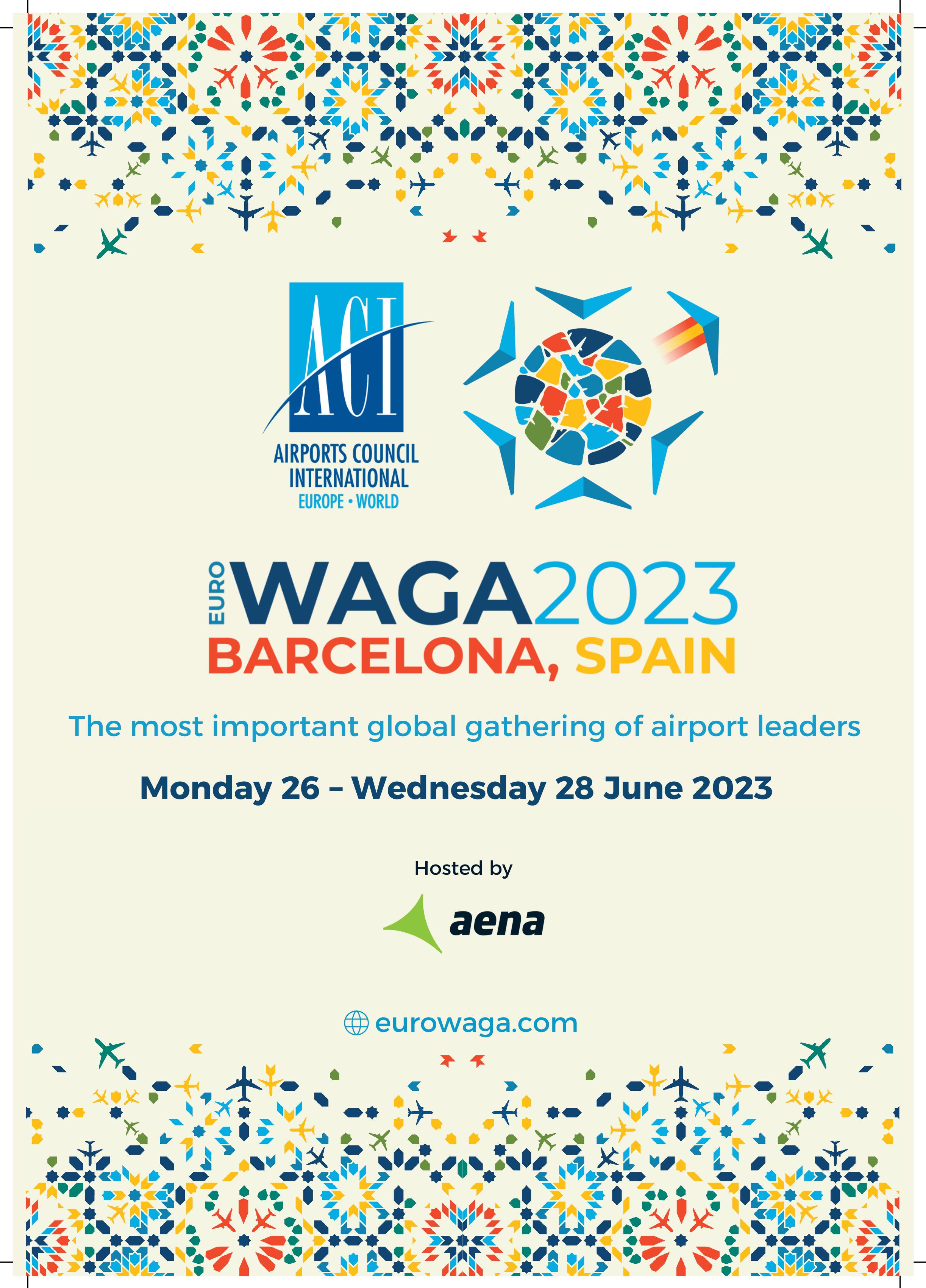Focus on: IT innovation

Airport profile: Sydney
Special report: Kansas City’s new terminal
Plus: ASQ Winners, Vertiports & Sustainability

Focus on: IT innovation

Airport profile: Sydney
Special report: Kansas City’s new terminal
Plus: ASQ Winners, Vertiports & Sustainability
Leading airport managers are not only focused on current recovery but also how to redesign and manage the airports for the next century. And technology and location intelligence will be key to that success. Esri geographic information system (GIS) technology gives you the power to

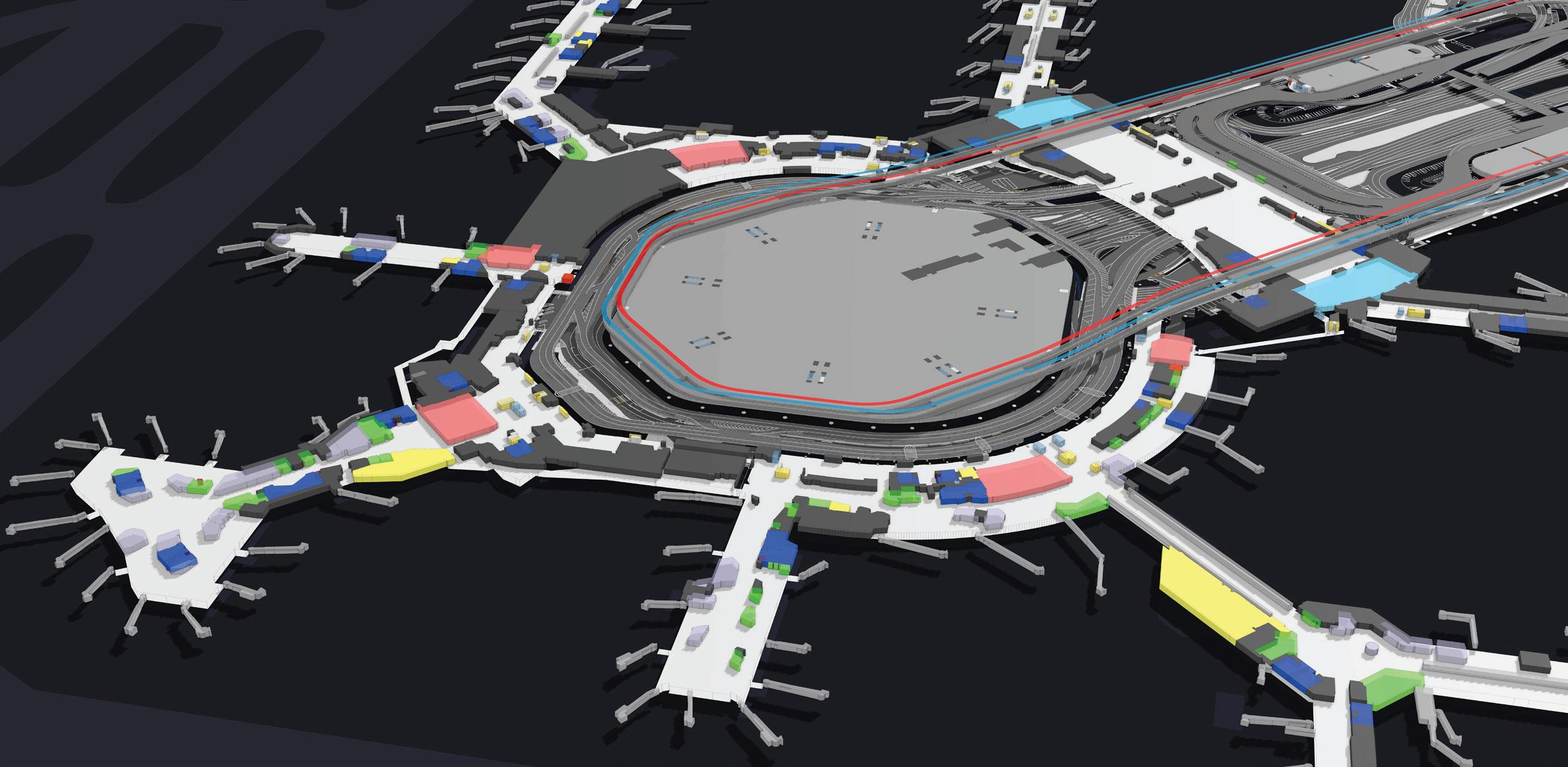
• Better design and manage the construction of new facilities.
• Better manage and maintain terminal and airside assets.
• Improve performance and efficiency.
• Enhance customer safety and experience.
• Optimize your financial performance.
Take the next step with Esri’s GIS. Explore go.esri.com/esri-airports-brochure-2022.
Editor
Joe Bates +44 (0)1276 476582 joe@airport-world.com
Sales Directors
Jonathan Lee +44 (0)208 707 2743 jonathan@airport-world.com
Jon Sissons +44 (0)208 707 2743 jon.sissons@airport-world.com
Advertising Manager
Andrew Hazell +44 (0)208 384 0206 andrewh@airport-world.com
Design, Layout & Production
Mark Draper +44 (0)208 707 2743 mark@airport-world.com
Subscriptions subscriptions@aviationmedia.aero
Managing Director
Jonathan Lee +44 (0)208 707 2743 jonathan@aviationmedia.aero
The laughter of my nephew when I messed up a food order on a tablet in a restaurant the other day reminded me of my hilarity at watching my dad try and use a VHS video recorder for the first time back in the early 1980s.
In fairness to my dad, he was born in a different age, and using technology was alien to him. I can offer no such excuses, of course.
Indeed, today we rely on technology for pretty much everything we do and and living life without it seems almost inconceivable. Just imagine being without your laptop or mobile phone for a month? How would we survive?
You can read about some of the latest IT developments at airports and the potential technologies to come in the 'IT innovation' themed section of this issue of Airport World
ACI World's senior director for security, technology and innovation, Billy Shallow, introduces the IT innovation section by considering how the smart use of data will continue to transform the airport industry.

Published by Aviation Media Ltd PO BOX 448, Feltham, TW13 9EA, UK Website www.airport-world.com
AirportWorld is published six times a year for the members of ACI World. The opinions and views expressed in AirportWorld are those of the authors and do not necessarily reflect an ACI World policy or position.
ISSN: 1360-4341
The content of this publication is copyright of Aviation Media Ltd and should not be copied or stored without the express permission of the publisher.
When I started work neither existed, and we obviously survived just fine, but it really cannot be overstated how much technology has changed the way we live, work and play since then. For example, back then, if I needed to do some background research for a big story, I would often spend hours or even days in libraries or public offices looking for old paper documents and files. Today, you can invariably find this information on the internet within a couple of minutes!
The impact of technology on the way we travel has been as equally dramatic. Just think about how we used to book holidays or flights in the old days. In most cases the process involved physically visting a travel agent or an airline office – often more than once – to make your booking. Today, you can do this all yourself from the comfort of your living room.
While at the airport itself, technology such as augmented reality, e-gates, self-service check-in and baggage drop machines, touchless kiosks and robotics, together with improved digital communication from airport operators and retail/F&B concessionaires, have hugely enhanced the airport experience. And the good news is that there is so much more to come.
The themed section also contains an interview with Elena Avila, head of the airport and airline operations business unit at Amadeus; and shines the spotlight on how the travel trends of tomorrow are shaping airport IT agendas today; anti-drone technology; IT-driven customer service innovation; and the digital transformation of airfield inspections.
Elsewhere in the issue, we salute the 2022 Airport Service Quality (ASQ) winners; discover more about Kansas City International Airport's new terminal; and ACI World director general, Luis Felipe de Oliveira, provides his thoughts on the key role technology, IT innovation and data will play in the future development and success of the world's airports.
Our main airport feature is on Sydney Airport (SYD), where CEO, Geoff Culbert, explains why the Australian hub is looking ahead with confidence and has big plans for the future.
If that's not enough, our Spring 2023 edition also contains articles about beginning the airport decarbonisation journey; the key role airports can play in unlocking the benefits of urban air mobility; our regular ‘people matters’ column; and the latest news from ACI's World Business Partners (WBP).
The 'IT innovation' theme of this issue provides Airport World editor, Joe Bates, with the chance to reflect on the constant growth and development of new technology.

3 Opinion
The 'IT innovation' theme of this issue provides Airport World editor, Joe Bates, with the chance to reflect on the constant growth and development of new technology.

9 View from the top
ACI World director general, Luis Felipe de Oliveira, reflects on the key role technology, IT innovation and data will play in the future development and success of the world's airports.
10 ACI News
We report on the top 10 busiest airports in the world in 2022, the infrastructure development challenge in North America, and Airport Carbon Accreditation success in Africa and Europe.
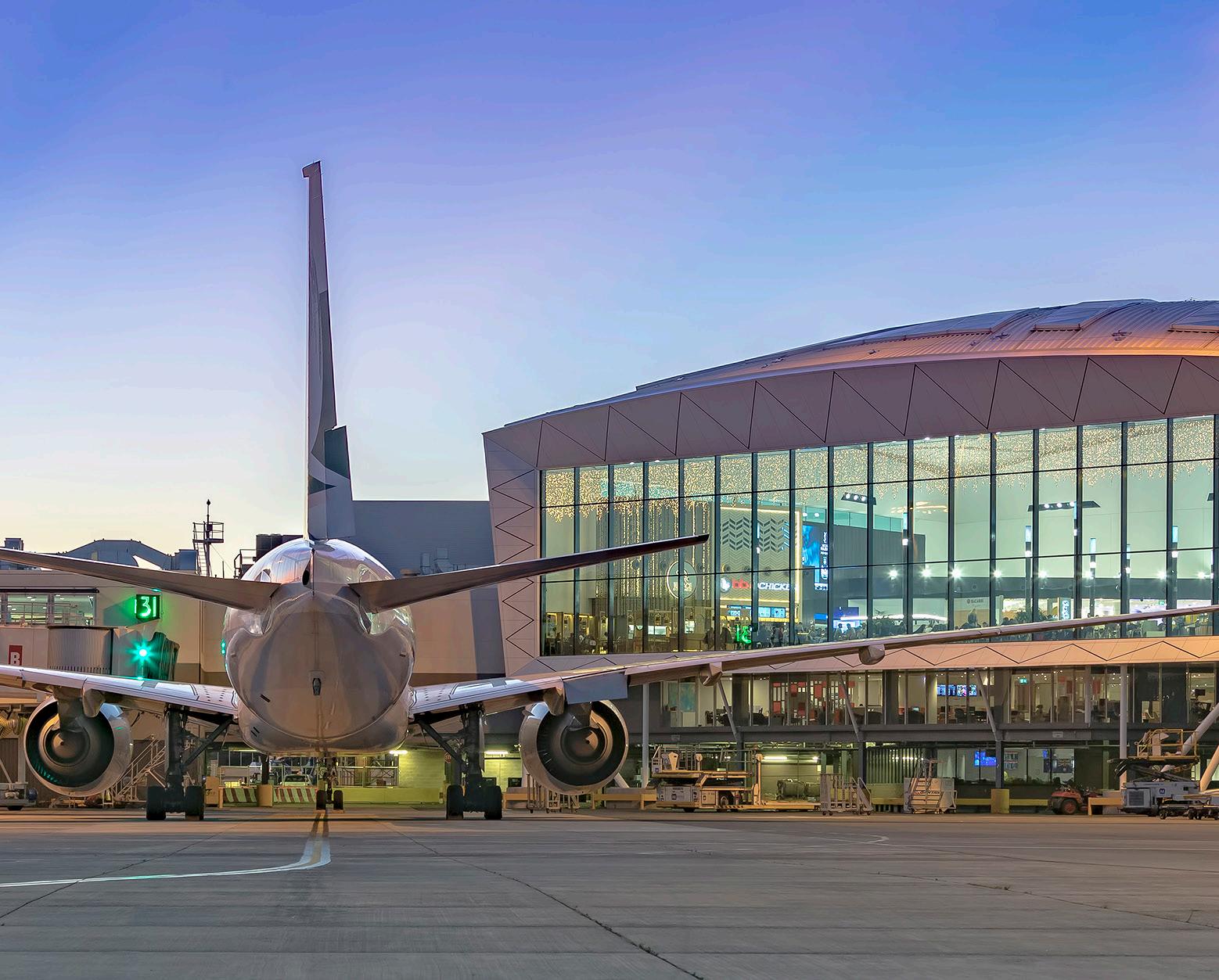
14 On the comeback trail
CEO, Geoff Culbert, talks to Joe Bates about Sydney Airport's recovery from the global pandemic and ongoing efforts to enhance the Australian hub's facilities and services.
18
ACI World's senior director for security, technology and innovation, Billy Shallow, considers how technology and the smart use of data will continue to transform the airport industry.

20
SITA Americas' head of technology, Sherry Stein, explains how the travel trends of tomorrow are shaping airport IT agendas today.

22 Click and go!
Clare Williams Fannin of Templemere PR explores how innovative tech is transforming the airport passenger experience.
Elena Avila, head of the airport and airline operations business unit at Amadeus, talks to Airport World about some of the IT challenges, and potential solutions, facing airports today.
Esri's global transportation industry director, Terry Bills, explains how the digital transformation of airfield inspections has enhanced safety and operational efficiency at two very different US gateways.
Radio frequency cyber technology can help combat the dangers posed by the growing number of rogue drones flying close to airports and, in some cases, breaching the perimeter fence, writes Jeffrey Starr, CMO of D-Fend Solutions.

We pay tribute to ACI World's 2022 Airport Service Quality (ASQ) Award winners whose customer service excellence continues to enhance the airport experience for passengers.
Kevin Cox, CEO of Ferrovial Vertiports, considers the key role airports can play in unlocking the benefits of urban air mobility.
Airport World reports on the planning, design and opening of Kansas City International Airport's new $1.5 billion terminal.
Blueprint Power's chief technology officer, Nick Schmidt, considers some of the energy monitoring and emissions reducing options open to airports at the beginning of their decarbionisation journeys.

The latest news and views from ACI’s World Business Partners.
Dr Richard Plenty and Terri Morrissey reflect on the implications of ChatGPT for the world of work.
Director General
Luis Felipe de Oliveira (Montréal, Canada)
Chair
Aimen Al Hosni (Muscat, Oman)
Vice Chair
Candace McGraw (Cincinnati, USA)
Immediate Past Chair
Martin Eurnekián (Buenos Aires, Argentina)
Treasurer
Arnaud Feist (Brussels, Belgium)
ACI WORLD GOVERNING BOARD
DIRECTORS
Africa (3)
Emanuel Chaves (Maputo, Mozambique)
Fabrice Grondin (Saint-Denis, Réunion)
Capt Rabiu Hamisu Yadudu (Lagos, Nigeria)
Asia-Pacific (9)
Aimen Al-Hosni (Muscat, Oman)
Mohamed Yousif Al-Binfalah (Bahrain)
Geoff Culbert (Sydney, Australia)
SGK Kishore (Hyderabad, India)
Seow Hiang Lee (Singapore)
Emmanuel Menanteau (Paris, France)
Nitinai Sirismatthakarn (Bangkok, Thailand)
Akihiko Tamura (Tokyo, Japan)
1 Vacancy
Europe (7)
Arnaud Feist (Brussels, Belgium)
Jost Lammers (Munich, Germany)
Javier Marin (Madrid, Spain)
Yiannis Paraschis (Athens, Greece)
Kadri Samsunlu (Istanbul, Turkey)
Stefan Schulte (Frankfurt, Germany)
Nazareno Ventola (Bologna, Italy)
Latin America & Caribbean (3)
Ezequiel Barrenechea (Guayaquil, Ecuador)
Mónika Infante (Santo Domingo, Dominican Republic)
Juan José Salmón (Lima, Peru)
North America (6)
Kevin Dolliole (New Orleans, USA)
Deborah Flint (Toronto, Canada)
Joseph Lopano (Tampa, USA)
Candace McGraw (Cincinnati, USA)
Sam Samaddar (Kelowna, Canada)
Roelof-Jan Steenstra (Toronto, Canada)
Regional Advisers to the World Governing Board (10)
Lew Bleiweis (Asheville, USA)
David Ciceo (Cluj-Napoca, Romania)
Alex Gitari (Nairobi, Kenya)
Fred Lam (Hong Kong)
Tan Sri Bashir Ahmad Abdul Majid (Delhi, India)
Mpumi Mpofu (Johannesburg, South Africa)
Andrew O’Brian (Washington DC, USA)
Jorge Rosillo (Galapagos, Ecuador)
Brian Ryks (Minneapolis-St Paul, USA)
1 Vacancy
WBP Observer
Esperanza Morales Martin (Global Exchange)
Correct as of April 2023
Solving complex challenges demands a special type of consultant – a consultant that captures the big picture without losing sight of the smallest detail.
Learn how our strategic vision, industry-focused expertise, and pre-decisional support services can help you address challenges.

www.ricondo.com

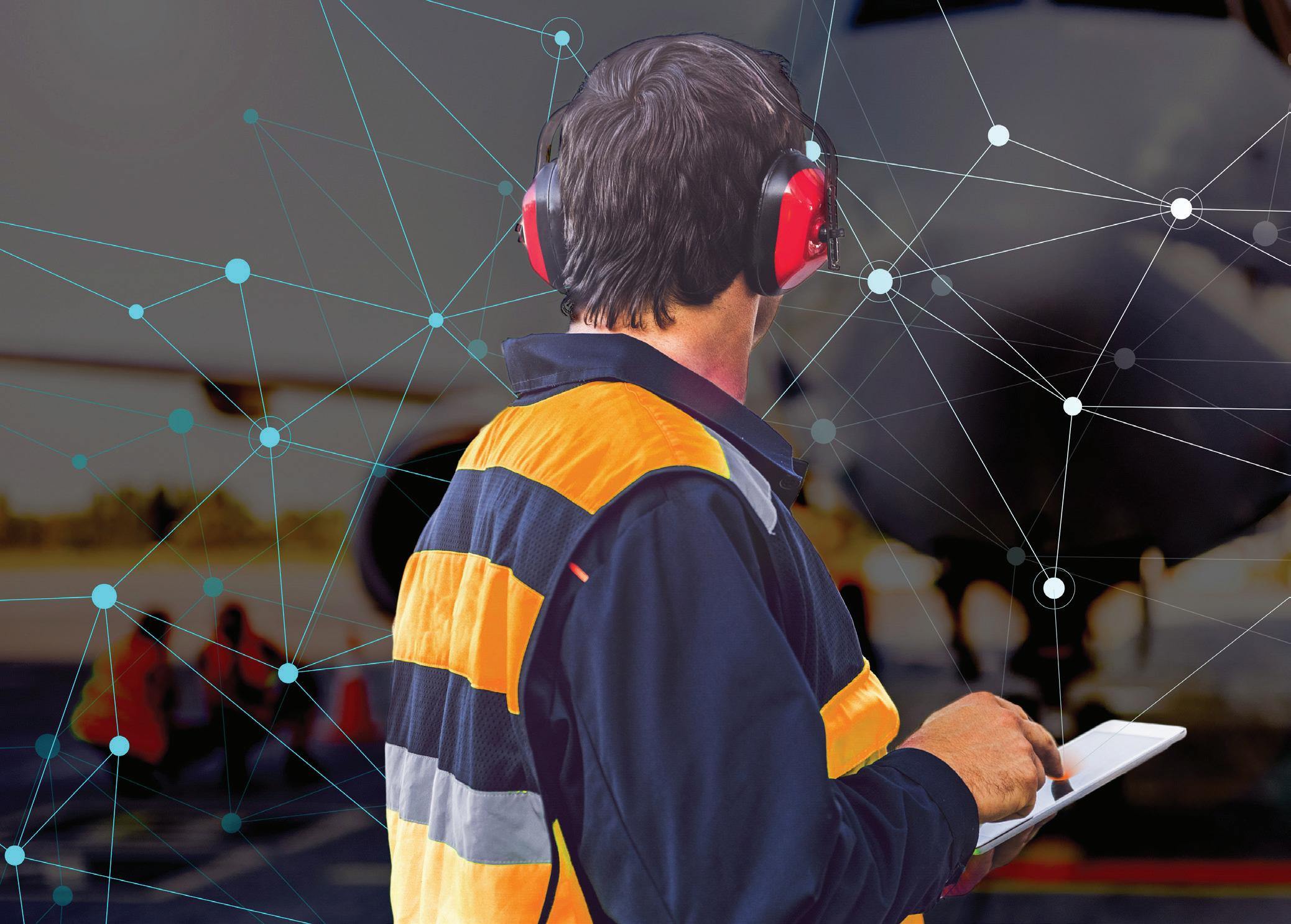
ADB SAFEGATE applies automation, integration and digitalization to provide an intelligent approach to managing apron activities from landing to takeoff. Our innovative Intelligent AiPRON platform integrates all the systems and processes important to apron operations into a single ecosystem that uses machine learning technologies to unleash the power of data and predictability.
Advanced docking systems ensure safe and precise aircraft stops every time, even in poor visibility. Operational data is constantly analyzed and presented to stakeholders in real time to improve decision making, mitigate irregularities and create recommendations to help deliver on-time departures. All of which equals faster, safer and greener turnarounds that boost the customer experience.



Collaboration across the entire aviation ecosystem is essential to ensuring that it can function efficiently and grow sustainably.
After all, all aviation stakeholders share the biggest challenges – namely meeting the growth of air travel demand and reaching the long-term environmental goal of net zero carbon emissions by 2050, all amidst the current macro-economic setting of mounting debt levels, increase energy costs, workforce challenges, and other inflationary pressures.
Technology is key to facing our shared challenges to best serve travellers and communities worldwide. It is fundamental to improving operations and optimising the passenger experience across the travel journey.
In fact, according to key findings from the latest ACI World-SITA Airport IT Insights Survey – the most extensive study of IT trends within the global airport industry – airport chief information officers (CIOs) are eager to leverage IT solutions to fortify their operations against disruption while automating the passenger experience.
The industry’s IT spend is projected to continue its steady year-on-year growth trend since 2020 to support this push for digitalisation, with 93% of airports expecting their IT spend to stay the same or increase in 2023 compared to 2022. Last year’s airport IT spending rose to an estimated $6.8 billion.
And ACI World is here to help. The ACI World Airport IT Standing Committee (WAITSC) plays an important role in shaping ACI’s policy and guidance on technology. Among many of its successes, it delivered extensive guidance on digital transformation at airports during the pandemic.
In the past year, ACI World has been exploring and producing several resources to support our members in key IT areas including in the realm of Artificial intelligence (AI) and Machine Learning (ML).
The Implementation of AI and ML in the Security Checkpoint Whitepaper,supported by both Pangiam and Rheinberry, provides an excellent overview of what AI and ML are, how they work, and how they can benefit airports, including better security, efficiency, and a more seamless passenger journey.
Indeed, technology is key to sharing data and communicating across aviation stakeholders, including airlines, airports, ground handlers, and control authorities. In this regard, ACI World has several key initiatives, including the long-standing Aviation Community Recommended Information Services (ACRIS), which sets the standard for information and data exchange across aviation stakeholders through one common language.
The definition and implementation of standardised business processes and interoperable IT solutions is a vital issue for the global
aviation industry, especially as a way to improve efficiency and to increase revenues.
In terms of leveraging data as a strategic asset, ACI World’s senior director of security, technology and innovation, Billy Shallow, in this issue delves into the Smart Data Hub concept, which takes a holistic approach to delivering business value from investments in enterprise data capabilities, helping airports become truly smart airports and deliver tangible business benefits.

And finally, but certainly not least, it is with great pleasure that we begin speaking about a new data project that we have been developing to provide live data in a standardised format to be consumed and displayed to customers in multiple digital channels.
This initiative follows the success of the Health Measures Portal, where over 300 airports provided data in a standard API, managed by ACI World and displayed to over 1.2 billion consumers via a number of applications including Apple Maps.
The proof of concept will start later this year and focus on providing live security wait time data from multiple airports to various digital channels. Stay tuned for more announcements on this.
We report on the top 10 busiest airports in the world in 2022, the infrastructure development challenge in North America, and Airport Carbon Accreditation success in Africa and Europe.
The biggest jump in the top 10 was recorded by London Heathrow, which rose from 54th position in the rankings in 2021 to eighth following the re-opening of borders after two years of closures.
ACI World director general, Luis Felipe de Oliveira, said: “The new top 10 busiest airports for passenger traffic reflects the resilience of the airport and aviation industry, and the eagerness of passengers to travel by air.
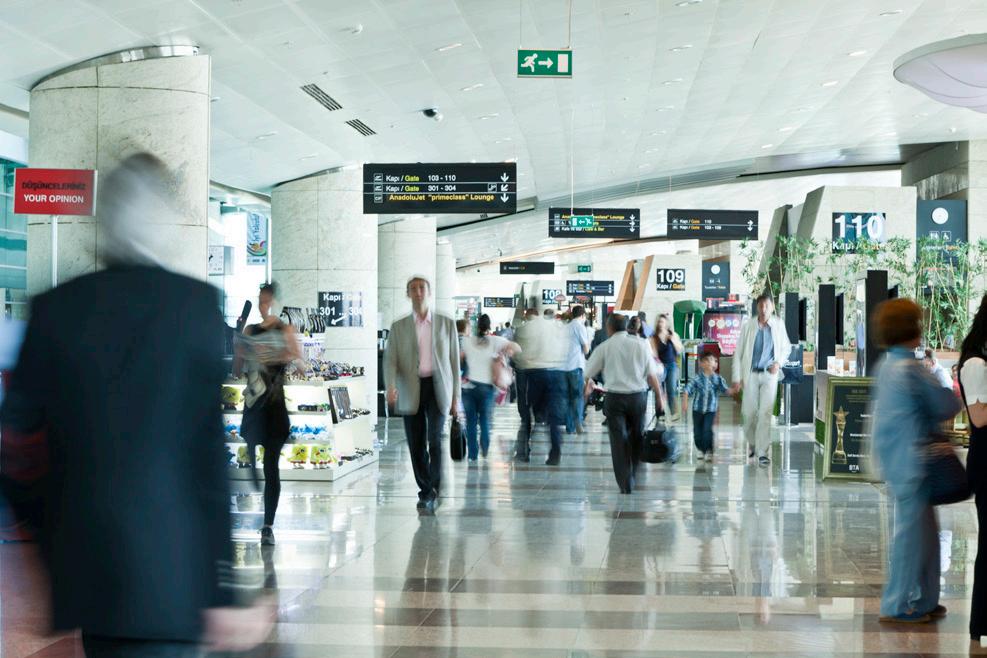
“While US airport hubs were able to recover quicker due to their strong domestic market, we are now witnessing global hubs joining the upper ranks – including Dubai, Istanbul, and London Heathrow.
“While we continue to march forward cautiously amidst multiple headwinds that could impact the speed and magnitude of global air traffic recovery, the latest rankings represent an important milestone in reaching pre-pandemic levels.
ACI World has revealed the top 10 busiest airports on the planet for passenger traffic, cargo and aircraft movements in 2022.
In terms of passenger traffic, the top 10 welcomed back some of the world’s largest hubs following the global re-opening of borders to international travel.
The upturn in passenger mumbers ensures that the table for the top 10 busiest airports on the planet now has a more familiar look to it after three COVID impacted years.
The top four airports actually remained the same as in 2021, HartsfieldJackson Atlanta (ATL) welcoming 93.7 million passengers (+23.8%) to retain top spot in 2022 followed by Dallas/Fort Worth (DFW) with 73.4 million (+17.5%), Denver (DEN) in third with 69.3 million (+17.8%), and Chicago O’Hare (ORD) in fourth with 68.3 million (+26.5%).
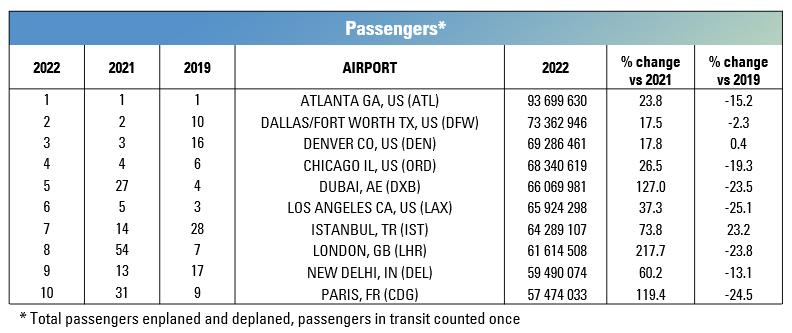
However, then, with the exception of Los Angeles (LAX) in sixth place with 65.9 million (+37.3%), the remainder of the top 10 was made up of airports either regaining their previously held status among the world’s busiest gateways – Dubai (DXB), London Heathrow (LHR) and Paris CDG (CDG) – or continuing their rapid upward trajectory for passenger growth such as Istanbul (IST) and Delhi (DEL).
From the top 10 airports globally, five are in the United States. They all have significant domestic passenger shares (between 75% and 95% domestic traffic).
“The ongoing recovery of air travel demand would not be possible without the continuous work of airports to provide a safe, secure, efficient, and sustainable air transport ecosystem for the passengers that we depend on and the communities we serve."
Preliminary figures indicate that with the resumption of international travel, global passenger traffic soared by 53.5% to close to seven billion passengers in 2022 – 73.8% of the total handled in 2019.
Air cargo volumes are estimated to have decreased by 6.7% year-overyear (-1.7% versus 2019), to close to 117 million metric tonnes in 2022.
Air cargo volumes in the top 10 airports for air cargo traffic –representing around 27% (30.8 million tonnes) of the global volumes in 2022, lost 9.9% in 2022 year-over-year (but kept a gain of 4.1% versus 2019 results).
The decline can be attributed to the ongoing geopolitical tensions and disruptions to global trade and supply chains.
Hong Kong (HKG) with 4.2 million tonnes (-16.4%) remained in the top ranked airport followed by Memphis (MEM) with 4.0 million (-9.8%) and Anchorage (ANC) with 3.5 million (-4.3%). Shanghai Pudong (PVG) slipped from third to fourth after handling 3.1 million tonnes of cargo (-21.7%) in 2022. Louisville (SDF) in fifth place handled just over 3.0 million tonnes of cargo (+0.5%).
The world’s airports handled close to 89 million aircraft movements in 2022, 20.4% more than in 2021. This represents a recovery of 82.5% from pre-pandemic levels (2019).
The top 10 airports for aircraft movements, representing close to 7% of global traffic (5.7 million movements), witnessed a gain of 11.4% from their 2021 results, recovering to 91.5% vis-à-vis their 2019 results (6.2 million in 2019).
ATL once again topped the rankings with 724,145 aircraft movements (+2.3% from 2021), although the total is less than it handled in 2019 when it finished second to Chicago O’Hare.

ACI-NA's newly released US airport infrastructure needs report, Growing Needs Heighten Urgency to Modernize America’s Airports, estimates that America’s airports need $151 billion over the next five years to fund necessary infrastructure projects, up more than 30% from $115 billion just two years ago.
“Investment in US airport infrastructure continues to lag behind the industry’s needs, and that gap continues to grow,” says ACI-NA president and CEO, Kevin Burke. “Continued infrastructure investment and reduced regulatory burdens for America’s airports will support good-paying jobs, stimulate the economy, advance important environmental goals, and improve the passenger experience for millions of travellers.
"It’s time for Congress to make meaningful reforms in how it funds America’s critical airport infrastructure.”
ACI-NA notes that airports are still recovering financially from the after-effects of the COVID-19 pandemic that decimated the entire global aviation system, stating that "the continued financial impacts of the pandemic have hamstrung airport investment in additional
modernisation projects to make the system more resilient before the next major disruption.
The total cost of these critical projects dwarfs the funding available through annual Airport Improvement Program (AIP) grants, Passenger Facility Charge (PFC) user fee collections, grant funding available through the Bipartisan Infrastructure Law, and net income generated by airports, says ACI-NA.
It notes: "Airports have a footprint in every community in America and are critical to the country’s economic success, supporting 11.5 million jobs and producing an annual economic output of $1.7 trillion.
"They depend on congressional authority and funding to modernise aging facilities, but regulatory burdens that have hamstrung airports for decades continue to constrain the industry’s ability to invest in infrastructure.
"Increasing AIP funding, expanding AIP eligibility, modernising the outdated PFC, and reducing regulatory burdens would allow airports to use funds in a way that benefits them the best, which in turn benefits the communities they serve." The full report can be found here.
ACI EUROPE believes that the efforts of the continent’s airports to reduce their carbon emissions meant that they emerged as "the standout star" of ACI’s Airport Carbon Accreditation annual report for 2021-2022.
ACI EUROPE director general, Olivier Jankovec, said: “European airports are leaders in carbon management globally, leaving no stone unturned in the effort to rid their infrastructure and operations of carbon, in line with the global climate goals and the ambitious climate agenda spearheaded by the EU."
In the period covered by the newly published report, European airports outperformed the global growth factor with a 32% increase in participation numbers, reaching 204 accredited airports at the end of the programme year (May 2021-May 2022).
ACI Africa also hails the carbon management progress of African airports, noting that despite the challenges posed by the COVID-19 pandemic, the continent saw "a remarkable growth rate
of 38% in airport participation", with 22 accredited airports across 13 countries.
The efforts of African airports have contributed significantly to global carbon performance, particularly in reducing Scope 1 and 2 CO2 emissions. During the reporting period (May 2021-May 2022), the accredited airports in the region collectively reduced their CO2 emissions by 15,439 tonnes, equivalent to the CO2 emitted during the production of nearly 2.2 million cotton t-shirts.
ACI Africa secretary general, Ali Tounsi, said: "The report is testimony of the airports' unwavering dedication to ridding their operations and infrastructure of carbon. Their efforts are commendable and have set an example for others in the industry to follow."
ACI Africa believes that the report confirms that African airports are not only committed to climate action but are also willing to go the extra mile to achieve their goals.
2023
June 26-28
ACI EUROPE/WORLD
Annual General Assembly, Conference & Exhibition
Barcelona, Spain
2023
September 30-October 3
ACI North America Annual Conference & Exhibition Long Beach, CA, USA
2023
November 21-23
Airports Innovate Muscat, Oman
ACI World
Luis Felipe de Oliveira
Director General
PO Box 302
800 Rue du Square Victoria
Montreal, Quebec H4Z 1G8
Canada
Tel: +1 514 373 1200
Fax: +1 514 373 1201
aci@aci.aero
www.aci.aero
ACI Africa
Ali Tounsi
Secretary General
Casablanca, Morocco
Tel: +212 660 156 916 atounsi@aci-africa.aero www.aci-africa.aero
ACI Asia-Pacific
Stefano Baronci
Director General
Hong Kong SAR, China
Tel: +852 2180 9449
Fax: +852 2180 9462
info@aci-asiapac.aero
www.aci-asiapac.aero
ACI Europe
Olivier Jankovec
Director General
Brussels, Belgium
Tel: +32 (2) 552 0978
Fax: +32 (2) 502 5637 danielle.michel@aci-europe.org www.aci-europe.org
ACI Latin America & Caribbean
Rafael Echevarne
Director General
Panama City, Panama
Tel: +507 830 5657/58 info@aci-lac.aero www.aci-lac.aero
2023
September 4-7
ACI World Customer Experience Global Summit Incheon, South Korea
ACI North America
Kevin Burke
President & CEO
Washington DC, USA
Tel: +1 202 293 8500
Fax: +1 202 331 1362
postmaster@aci-na.org www.aci-na.org
Airports Council International (ACI), the trade association of the world’s airports, is a federated organisation comprising ACI World, ACI Africa, ACI Asia-Pacific, ACI EUROPE, ACI Latin America-Caribbean and ACI North America. In representing the best interests of airports during key phases of policy development, ACI makes a significant contribution toward ensuring a global air transport system that is safe, secure, efficient, and environmentally sustainable. As of January 2023, ACI serves 712 members, operating 1925 airports in 171 countries.
THE GLOBAL AIRPORT COMMERCIAL REVENUES CONFERENCE
25 & 26
Hosted by Organised by
CEO, Geoff Culbert, talks to Joe Bates more about Sydney Airport's recovery from the global pandemic and ongoing efforts to enhance the Australian hub's facilities and services.
At October's ACI Africa/World Annual General Assembly, Conference & Exhibition in Marrakech, you described what a difference a year had made in terms of SYD's recovery from COVID. Six months on, are things looking even better for you? Yes, absolutely. Australians have rushed back to travel, both domestically and internationally. After two years of being cooped up at home, people are keen to explore the country and see the world again.
Domestically, passenger traffic was 82.9% recovered in February, compared to pre-COVID levels. However, our international passenger numbers are lagging and were only 76.3% recovered in February compared to February 2019. The challenge is the lack of capacity, which is translating to high airfares. We need to get more international capacity, so airfares come down. Australia is a long way from the rest of the world, and it is expensive to get here, so that handbrake needs to be released.
Australia also needs a sustained recovery in aviation capacity to support the recovery of key export markets including high-value agriculture, business travel, and international students.
Why was the recent launch of Vietjet flights to SYD so significant?
It was significant because it marked a major milestone for Sydney Airport. For the first time in our proud 103-year history, we have 50 airlines flying through Sydney Airport. This is an incredible achievement when you consider air travel was almost non-existent through COVID.
We now have four airlines flying to Vietnam and, in total, have onboarded six new airlines over the last 12 months, and existing
airlines have returned and are continuing to increase capacity, providing great opportunities and choice for the travelling public.
Attracting airline networks to rebuild capacity to Sydney is key to supporting the recovery of international tourism, business travel, student travel and the broader New South Wales economy.

The Vietnam market has experienced a strong surge in capacity and demand, with passenger volumes 14% above pre-COVID levels in March 2023.
We’re thrilled to welcome Vietjet to Sydney Airport, as the airline will be providing a further low-cost option to this sought-after and popular destination. As Australia marks the 50th anniversary of diplomatic relations with Vietnam it’s fitting that our 50th airline is a Vietnamese carrier.
Before COVID hit we knew that aviation was an ecosystem, and all the parts needed to work together seamlessly for the whole system to work, but COVID really reinforced that.
We have 800 different businesses operating at SYD. Pre-COVID they employed 30,000 people, and during COVID 15,000 jobs were lost.
When all the state-wide travel restrictions eased and the international border re-opened in early 2022, Australians were desperate to travel again, and we were inundated with passengers. However, filling all the crucial jobs across the airport to cater for this
surge in air travel was a huge challenge, especially as Australia was facing its tightest labour market in almost half a century, and this led to operational challenges in the first half of last year across the entire airport ecosystem.
Do you think the pandemic will have a lasting impact on not only the way we travel but also the popularity of certain destinations due to the perceived 'hassle factor' of travelling?
The travel patterns of our passengers are beginning to move back to what they looked like pre-COVID. Once we see the last of the international restrictions removed, we expect the visitors from all the previously popular destinations, especially China, to return in force.
SYD has been busy revamping its retail and F&B facilities and offerings for a number of years. Can you tell our readers more about the most recent developments and the reasons behind the transformation?
In February, we officially unveiled SYD X, the redeveloped T1 International Terminal luxury shopping precinct. We have 20 of the world’s most desirable brands all under one roof, including Louis Vuitton’s first retail travel store in the Southern Hemisphere.
The Luxury brands at SYD X include Bottega Veneta, Burberry, Bvlgari, These Dior, Gucci, Hermès, Prada, Rolex, Tiffany & Co and Valentino, and they will be joined by Cartier and Versace mid-2023.
As part of the project the ceiling height was more than doubled from four metres to nearly 10 metres and the precinct footprint was increased to 2,700sqm. We have created a unique luxury shopping destination for international travellers, which we think is one of the best in the world.
Sydney Airport now also boasts Australia’s first hotel inside an airport, with Aerotel opening in the T1 International terminal in August last year. It offers unparalleled convenience as it’s just a minute’s walk from the arrivals gate and 100 metres from international check-in.
Work also recently finished on the transformation of our T1 International Terminal forecourt. The team has created a beautiful and functional green space where people can gather, celebrate, and reconnect after getting off a long-haul flight or being reunited with friends and family.
The new SYD sign on the grass near the main terminal exit been a huge hit, with tourists flocking to it to get their first selfie in Sydney.
Does retail/F&B income provide your biggest source of non-aeronautical related revenue and how important is this income to ensuring the future growth and development of Sydney Airport?
Enhancing the customer experience remains a central focus for Sydney Airport, and having a wide selection of retailers and food and beverage options is one of the key elements.

While retail is one of our important sources of revenue, our property, hotel, and ground transport portfolios are also crucial.
Expanding the current terminals, building a new satellite pier, and enhancing the airfield are key elements of your 20-year development plan (Master Plan 2039) unveiled in 2019. Is this still the case?
We intend to keep building the infrastructure and capacity to cater for every passenger and airline that wants to fly to SYD.
While COVID temporarily delayed the roll out of some projects, we have recently completed a number of important projects, including a major runway resurfacing project, the complete refurbishment of the Terminal 1 forecourt and a new luxury shopping precinct in T1.
The good news is that aviation activity at Sydney Airport is continuing to recover strongly and we have just adopted a renewed, five-year capital works pipeline that runs to more than A$2 billion.
Next year, our capital expenditure budget will be nearly 60% bigger than it was in 2019, and we will be investing more than a A$1.3 million a day in projects to further improve the customer experience, accommodate growth and enhance capacity.
You plan to redevelop the P1 domestic car park, but with autonomous vehicles coming that could potentially drive away after dropping their occupants off at the airport, is this perhaps an unnecessary expense?
As a business, we are always looking to the future and the redevelopment of the 54-year-old P1 carpark is no exception. We expect that there will still be demand for car parking, but we’re excited by the opportunity to bring other ideas to life. We will definitely take into account future trends and emerging technologies.
Master Plan 2039 also includes SYD's Five-Year Ground Transport Plan and 20-year Ground Transport Strategy to enhance surface access and connectivity to SYD. What will these projects involve and why are they so important?
Like all major city airports around the world, we recognised that traffic is a real pain point for people and that’s why we are investing so much in alleviating congestion. Recent road upgrades and traffic management strategies have already improved journey times, but there is more work to be done.
Key projects we’ve completed to reduce congestion include building new and wider roads entering and exiting both our international and domestic terminal precincts.
However, the real game changer will be the new A$2.6 billion Sydney Gateway Road. Anyone who has travelled to the airport recently will know its construction is well underway. This new toll-free connection will significantly cut travels times from Western Sydney to the airport.
The sustainable development of SYD is said to be embedded into the master plan. Can you give some examples of how and, perhaps, tell us more about the airport's commitment to reducing its carbon footprint?

Sydney Airport has a strong track record on incorporating sustainability into its operations and in recent years entered into a power purchase agreement for renewable energy and developed market-leading financial instruments like sustainability-linked bonds and loans.
We have also implemented several energy efficient projects including a large solar PV array on one of our car parks and electrification of our bus fleet. We have also invested significantly in a recycled water treatment plant and reticulation network.
We have clear targets of being carbon neutral by 2025 and reaching net zero by 2030, and we are working closely with the industry on sustainable aviation fuel initiatives. Like everyone in the industry, we know how critical this is.
In 2022, all-cargo flights made up 7% of the total aircraft movements at the airport, down significantly from 18% in 2021 when there were still major travel restrictions.
What many people don’t realise is that 80% of air freight is carried in the belly of commercial aircraft, so we see the growth of freight indexed to passenger growth.
Do you think that the pandemic will make it even more difficult for SYD and the world's airports to recruit and hold on to good staff?
We’ve been delighted to see many workers who left aviation during the pandemic come back now that we’re flying again. Once you have jet fuel in the blood, it’s hard to stay away.




ACI World's senior director for security, technology and innovation, Billy Shallow, considers how technology and the smart use of data will continue to transform the airport industry.
If we look at the glass being half full instead of half empty, recent flight delays and disruption could actually be seen in a positive light as it means that the aviation industry's recovery from COVID and return to pre-pandemic traffic levels is well underway, and the world is fully open to business.
ACI World forecasts that traffic levels in 2023 will be at 92% of 2019 levels and this is an exciting time for aviation. The pent-up demand has demonstrated that passengers want to and are travelling again.
However, we cannot go back to how airports were managed before. Building more infrastructure is not a sustainable way to manage the expected level of growth.
Airports need to become smarter, making use of digital transformation to become more efficient and make journeys as seamless, safe, and secure as possible, whilst utilising undervalued opportunities such as through enhanced non-aeronautical revenues.
As an industry, IT spend is projected to continue its steady year-on-year growth since 2020 to support this push for digitalisation, with 93% of airports expecting their IT spend to stay the same or increase in 2023 compared to 2022. Last year’s airport IT spend rose to an estimated $6.8 billion.
Airports across the world are investing in key technologies to improve the passenger journey, reducing bottlenecks in the process, and optimising resources. Whilst some of these technologies are not new, such as self-bag drops and biometric journeys, there are new innovations that can really shape the journey of the passenger.
Business intelligence solutions are also at the forefront of airport IT investment priorities, with 93% or more airports planning business intelligence initiatives for asset management and flight operations by 2025.
Data has been seen as the new oil: The most valuable asset in the world. Airports are becoming more advanced in how they set up and manage Smart Data Hubs. A Smart Data Hub takes a holistic approach to delivering tangible business benefits from investments in enterprise data capabilities. This often includes:
• Providing strategic business capability to realise the full potential of data
• Enabling all stakeholders to connect, share data responsibly, and drive confident decision-making
• Allowing users to extract meaningful insight into enterprise performance and its key drivers
• Empowering users to share data between processes and provision data for operational reporting, analytics, and Machine Learning/ Artificial Intelligence
• Offering a flexible and cost-effective approach as the capability can be implemented as a basic functionality or scaled based on the airport data maturity level and business needs
The core components of a Smart Data Hub includes culture, governance, data providers, data consumers, people, and technology. All of these foundations should be carefully understood before embarking on a data journey.
ACI World will soon release its Smart Data Hub Handbook, enabling airports to fully plan, prepare, build, and manage an application of a Smart Data Hub, and also, allowing for the assessment of each airports’ data maturity application.

ACI World is looking to support airports with their data programme, which will enable opportunities for airports to improve operational efficiency, increase revenue, and provide an improved passenger experience.

Later this year, in a global first; ACI World will create and launch a data exchange platform, allowing multiple data sources from airports to be consumed by different firms, such as large tech firms, travel agents, airlines, and airport partners.
The proof of concept allows for live security wait time data from a number of the world’s airports to be provided through the Application Programme Interface (API) Platform, delivering information across multiple digital channels and reducing integration costs for airports.
This wait time data already exists on the airport’s apps or websites but would now be more easily accessible to passengers through different ways, offering them a better chance to plan for their journey from home to the departure lounge.

The idea was born out of ACI World’s Health Measures Portal, where 338 airports shared health information data during the pandemic, in an ACRIS compliant and standardised format, and was displayed to 1.2 billion devices in the Apple Maps application.
Data is also re-shaping some of the airport operational processes. Zooming in on the security process, the most stressful part of an airport journey, there are key initiatives that will fundamentally see how the journey becomes more efficient over the next five years.
The use of Artificial Intelligence and Machine Learning data in the security checkpoint, will enable unseen levels of efficiency in the screening process whilst improving the level of security effectiveness.
Across the world, the use of advanced technologies such as computed tomography machines that can detect explosives are either being implemented by airports or mandated by regulators. Therefore, explosives are automatically detected, in turn reducing the threat risk.
The further exciting developments include Automated Prohibited Item Detection (APIDS) algorithms that have the capability to automatically detect other threats such as guns, knives, and weapons.
ACI World’s Smart Security programme works closely with the International Civil Aviation Organization (ICAO) Working Group on Innovation to trial such technologies and understand the best practices of adopting new technology. The use of data imagery will help automate the process, improving security whilst speeding up passenger journeys, with the potential to eliminate queues.
There are countless opportunities to transform the aviation industry through technology and innovation. Data should be used as a strategy by airports and the industry as a whole to drive performance, enhance the offering, and deliver a smoother and more efficient journey for the passenger with better integrated processes.
Data does, however, need to be clean to be effective. The old saying of if you put garbage data in, you’ll get garbage out continues to be relevant. We certainly don’t need anymore garbage in the world.
SITA recently released two pieces of research giving a glimpse into the transformational change taking place or expected in the air transport industry. While the topics and timelines of these reports differed, clear lines connect the trends.
SITA’s Air Transport IT Insights 2022 shed light on the key investment priorities for airports and airlines in the next few years, while the Meet the Megatrends report looked at the underlying macro trends driving changing travel behaviour with a longer lens of 10 years.
The automation and emergence of smart airports, digital travel, multimodal travel, and technology to support sustainable travel dominate current investment trends and correlate to macro societal shifts.
A swifter-than-expected recovery of demand has confronted aviation CIOs with increased disruptions, baggage mountains, and staff shortages. While traffic volumes in 2022 rose to about 90% of 2019 levels, passenger traffic has been characterised by much higher volatility, with spikes during key holiday periods such as Easter and summer.
As airlines and airports sought to adapt to these spikes with reduced workforce and resources, operational challenges arose in many different areas, including baggage.
SITA’s management system for mishandled baggage, WorldTracer, recorded three times more mishandled bag reports for January to March 2022 compared to the previous-year period. From April to June 2022, the system showed five times more mishandled bag reports than in the second quarter of 2021.
The pandemic decimated workforces globally, and the air transport industry was particularly hard hit, with 62 million travel and tourism jobs lost in 2020. Despite strong recovery and growth over the last year, millions of jobs remain unfilled. This will continue to be a challenge throughout the remainder of 2023.
The volatility has led to airlines and airports looking to key technology solutions to fortify their operations against disruption while automating the passenger experience to achieve more with less.
Airlines and airports want to use IT tools to be more adaptable to disruptions and irregular operations, even amid staff shortages.
CIOs want to take a proactive approach to disruption, with 90% of airlines investing in disruption warning systems. Proactive communication with passengers is a priority, with 67% of airlines planning to provide real-time information such as flight status, wait-times, and baggage tracking info to passengers by 2025. Half of the airports are planning automated predictive alerts before flight disruption events.
Airlines and airports are investing in key technologies to smooth the passenger experience across every step of the journey, with biometrics and self-service seeing major emphasis.
Self-service technologies remained airlines’ top IT investment priority in 2022, with touchless solutions and biometric ID management following closely.

Airports’ implementation of a secure single biometric token across all touchpoints has surged from just 3% in 2021 to 39% in 2022, with over half planning implementation by 2025.
Zooming in on this last point, the surging implementation of a single secure biometric token across all touchpoints signals a strong commitment from airports and airlines to the next-generation travel experience where passengers can breeze through the airport using their face as their boarding pass.
The call for digital identity is not new, and we strongly support it. We are encouraged by the momentum from governments globally around digital identities, particularly as this relates to travel.
In fact, we see the International Civil Aviation Organization (ICAO) progressing swiftly towards a digital identity standard that will, in the coming years, result in the dematerialisation of physical documents such as passports, visas, or health forms.
Digital identities mean we will be able to travel from anywhere to everywhere – by air, land, or sea – without needing to show our physical travel documents.
And as the technology underpinning these digital identities mature, the benefits are enormous. For one, it gives the travelling public more control over what information they share and with whom. This is privacy
SITA Americas' head of technology, Sherry Stein, explains how the travel trends of tomorrow are shaping airport IT agendas today.
by design. Also, this move supports an era of digital borders where the immigration checkpoint is pushed to the point of departure.
Passengers can provide all the documentation for a trip – visa, passport, and flight details – well in advance and arrive at the airport, rail station, or port ready to travel. That means a quick scan of your face or mobile phone is all that will be needed.
Travel and tourism are fundamental pillars of rebuilding economies globally. Therefore, we should make the passage of travel as easy and safe as possible. Digital identity is the cornerstone of that experience. Digital travel will also greatly ease the operational strains on airport congestion and create a smooth passenger journey.
There will be a push for more connected journeys with sustainable operations and new collaboration models using trusted data exchange for the broader end-to-end travel ecosystem. We will move from a community of 40+ players to take care of a single flight offer from A to B, towards an ecosystem of hundreds of active contributors to deliver a door-to-door experience.
As travel becomes more connected and intermodal, having unified digital systems that simplify the passenger journey across land, sea, and air will become increasingly important.
The challenge ahead is to create seamless, near-walkthrough digital experiences in a multimodal context, combining Air&Rail, Air&Cruise (or even Air&Events) to help the ‘connected travel’ concept become a reality.
Building a trusted framework for sharing data in an ecosystem of hundreds of travel and related industries is critical for this to become successful. Collaboration is key.
The 2022 UN Climate Change Conference (COP 27) saw a renewed commitment to achieving net-zero carbon emissions by 2050. Passengers’ growing awareness is one of the most significant shifts in recent years.
According to SITA’s 2022 Passenger IT Insights survey, almost all passengers are ready to pay to offset the carbon emissions generated
by their flights. More than 9 out of 10 passengers stated they would be willing to pay to offset emissions.
Operational improvements are a primary measure to enable the industry to directly and more immediately reduce its emissions by up to 10% – efficiencies that can be achieved through today’s technology.
For example, airports can process passengers swiftly, even enabling remote check-in before arrival, by deploying passenger processing and self-service technology. This enables airports to maximise their existing investment without having to invest to expand their physical footprint.

Using technology to harness data for greater situational awareness and more informed decision-making is also key to realising efficiencies and emission reductions. For example, SITA is trialling a new emission management capability as part of our Airport Management solution to enable Palermo Airport to improve the measurement and optimisation of emissions in and around the airport.
Airlines are investing in solutions to improve situational awareness and reduce fuel burn, emissions, and costs while building climate resilience by integrating solutions such as the eWAS Pilot and OptiFlight applications.
The results are immediate and concrete. Climb fuel savings of 5% are possible for each flight without affecting passenger safety or comfort.
Improvements in aircraft design, fuel efficiency, engines, and materials will significantly affect efficiency and sustainability and will be a key focus for airlines. Sustainable Aviation Fuels will become ubiquitous and substantially cheaper than they are today, while hydrogen and electric engines for commercial use promise even more efficiency when these technologies mature in the following decades.
As eVTOLs and vertiports come to maturity and meet regulatory approvals, we’ll see a growing shift in short-haul traffic. Urban Air Mobility (UAM) will offer a new form of sustainable aviation with multiple mobility options to cities worldwide.
If there is one positive thing to emerge from the COVID pandemic, it’s that it has spurred the air transport industry to think differently. The trends, both near and long-term, show airports and airlines are not afraid to try new ways to solve old problems and invest in smarter, more resilient, and agile operations to prepare for an uncertain future.
By definition, airports are tech-forward spaces. But technology shouldn’t only be reserved for the complex processes of managing flights. It also has a role to play in helping to deliver the best possible experience to passengers.
Mark Smith, chief digital and technology officer, at food and beverage operator, SSP, says that airport passengers are happy to engage with technology when it makes the experience more efficient, but can be frustrated if the technology is too complicated or doesn’t work.
“We know that peoples’ stress levels can often be heightened at airports, which is why tech needs to do what it promises, and providing things like charging points and good quality Wi-Fi are basic hygiene factors that the customer now expects,” he notes.
Using technology to give passengers information that puts them in control of the time they spend in the terminal is important, according to Smith, and SSP is introducing a number of initiatives, such as screens displaying current kitchen wait times on orders, which give customers the comfort of knowing how long they will need to wait for their food.
The need for speed and convenience at the airport means it’s an environment that is particularly suited to self-service propositions. These have now been elevated to new levels of sophistication. SSP, for example, plans to open a number of convenience stores that operate completely autonomously.
Shoppers simply scan a credit card to enter the store, take what they want, walk out and their card is charged accordingly. Similarly, refined vending options can provide solutions in areas of the airport where there is not enough passenger traffic to run a manned store 100% of the time.

Encouraging pre-ordering has long been a priority for SSP, but new technologies are making this a much more viable option. “‘Hot hold fridges’ are now available that can keep hot food fresh for a longer
period of time, so collecting food for your flight at a gate is now a possibility," says Smith.
"The acceptance of services such as Deliveroo and Just Eat on the high street means these options are likely to be similarly well received compared to just a few short years ago.”
Smith cautions that we need to be mindful that technologies that appear to be outlandish now may well be welcomed sooner than we think, particularly as Gen Z becomes an ever-larger percentage of our customer base.
“Only a few short months ago, very few people had heard of ChatGPT. Now, however, there will be no Gen Z who haven’t at least played with the artificial intelligence chatbot," he comments.
"We mustn’t underestimate our passengers' appetite to use and enjoy technology. When we introduced our service robots at Belfast Airport last October, for example, we knew they would improve efficiency and free staff to focus on serving customers, but we thought passengers might be put off by them.
"And so, we had the robots deliver to a central point in the restaurant for waiting staff to carry the plates to the customer. But the feedback we had was that customers really loved the robots and actually wanted them to bring their food to their table.”

There is plenty of scope for technology and AI to improve the lounge space, too. With demand currently high for lounge facilities and more passengers happy to pay for access, lounge operator, Airport Dimensions, is now using technology to monitor and manage entry.
“Passengers can book their lounge visit before they arrive at the airport, and keep tabs on what access is available,” says Tommy Planson, the company’s chief technology officer. “Virtual queueing systems mean
that passengers can check in with the lounge, and then enjoy some shopping, for instance, before they return to relax at the lounge.”
Airport Dimensions has also had considerable success with its Connecta In-Lounge Experience platform, which allows guests to access a range of services from their phones. At each location, it can be tailored to offer anything from F&B ordering for delivery to seats, to the option to book services such as showers or business pods, as well as access to a range of online media including newspapers, magazines and podcasts which can be curated for the location of the airport.
The platform has been well received, and the company has seen take up of over 90% where it’s offered.
Planson believes the scope to build on these offers is boundless. He says: “The next stage of digital innovation to improve the guest experience at the airport is to use AI to hyper-personalise the offer we bring to the lounge customers.
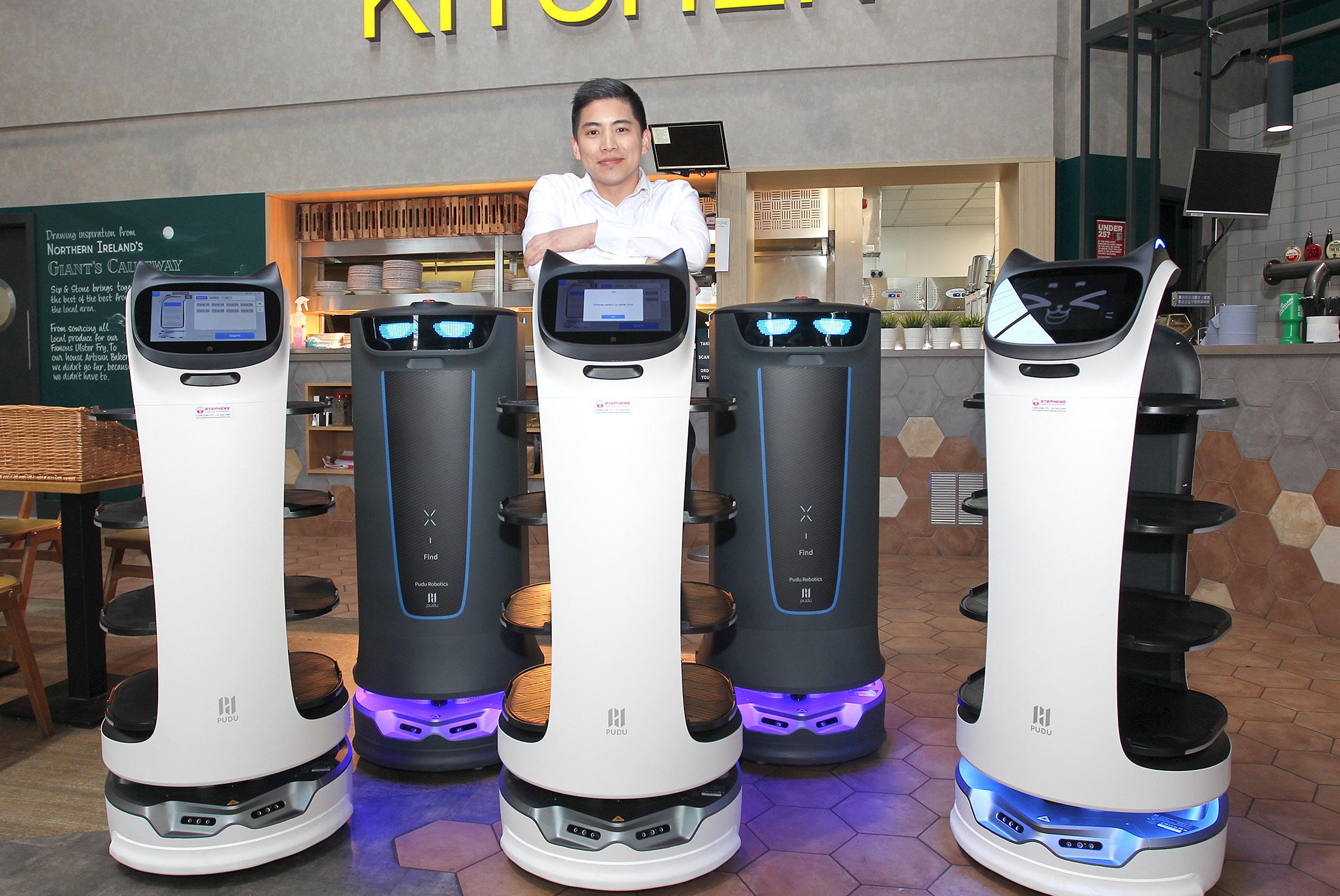
"AI can provide broad insight, which allows us to offer menu items or retail opportunities that are perfectly suited to each of our guest’s needs – whether that’s showing them retail offers that perfectly meet their individual travel needs, remembering they are allergic to dairy, or suggesting product combinations that are based on a genuine understanding of who that customer is and what their tastes are.
"This will give us an incredibly sophisticated way of keeping satisfaction high, while also boosting revenue throughvery intelligent upselling.”
While these are strong examples of tech improving the customer experience, again they’re a bi-product of this increased operational efficiency.
Planson adds: “Camera-based AI can be used to make the team’s lives easier by, for example, monitoring how often the bathrooms are used, so staff know when cleaning is required, or sending notifications when food areas need attention, freeing frontline team-members to deliver great service.
"In a similar way to how AI is used in high-street retail, footfall analytics can be used by airport staff to place products and F&B strategically, and reconfigure the lounge space according to day parts that fit the needs of passengers as they flow through the space.
"When this tech is used accurately to keep track of capacity, lounge operators are able to utilise dynamic price imaging depending on how busy the spaces are, ensuring revenue is maximised.”
One thing that will take the shine off any airport experience, no matter how welcoming the hospitality, is a delayed flight.
But managing that delay as smoothly as possible can help to alleviate some of the pain. And again, technology has a role to play here, according to Richard Bye, CEO of digital vouchering platform, iCoupon.
“Transferring any compensation value digitally to a boarding pass can go a long way towards taking away some of the stress of a delay and improving satisfaction at a difficult point in the journey," says Bye, noting that there are a number of reasons why this is the case.
“Digital vouchering technology doesn’t ask passengers to adapt their behaviour or learn anything new," States Bye. "Travellers simply have to show their boarding pass as they will have done many times before.”
Digital vouchering also means passengers don’t have their time at the airport disrupted, and they don’t have to go anywhere else, so they can carry on shopping or enjoying their meal. This convenience for the passenger improves the experience, but it can also be commercially advantageous for the airport.
Bye says: “Digital vouchers are much more likely to end up in the airport’s tills. With no time wasted queuing or navigating complicated e-wallet solutions, passengers have more time, and more inclination to spend their compensation.”
And with only around 35% of paper vouchers redeemed at the airport, this can make a significant difference to revenue, something Bye says ensures "a win-win for both passengers and airports.”
Technology cannot and should not replace old-fashioned hospitality – it should enhance it. It shouldn’t make the passenger’s experience more complex – it should make it less stressful.
If these caveats are heeded – it can make a real difference to how much passengers enjoy their time at the airport. AW
What would you say to those that argue that such is the rapid advancement of IT systems that any new technology is almost out of date within months of being installed?
I’d agree that this situation has been holding the industry back over recent years but that’s mainly due to the way technology has been managed at airports. Installing software on-site means it needs to be manually upgraded, it’s hard to bring it together with new innovations that emerge and it all costs more than it should.
Our aim when entering the airport technology industry has always been to change this by supplying modern and open technology from the cloud. Cloud software can be deployed quickly and cost-effectively, it can be integrated easily so different applications at the airport can talk to one another and it is the foundation for creating unified data that can be analysed for better operations. Amadeus has always designed its systems this way, and our solutions for operations and the passenger experience provide this flexibility today.
Cloud technology is critical to any platform approach, and this approach will maximise technology innovation across the aviation community, and importantly – it will future-proof the airport’s IT investment.
Biometrics is a great example. Designing a biometric platform in the cloud can be a key enabler to simplify its deployment and accelerate adoption. Offering end-to-end biometric experiences to passengers requires a complex integration involving multiple stakeholders. Airports and airlines can attempt to build these individual links themselves using APIs, but that effectively requires them to become systems integration firms, which is costly and time-consuming.
Our approach allows an airline to look at a map of airports where our biometric cameras are installed and choose to implement biometrics at them all, with just one connection to the cloud. The reverse is also true, and airports can more easily onboard airlines to their biometric programmes.
Does new technology, especially in the form of kiosks/ equipment, inevitably mean high electricity costs for airports at a time when many operators are looking to reduce their raising energy bills?

Sustainability is high on the agenda for airports, and again cloud computing can be leveraged to help them operate in a more environmentally friendly way. By migrating to the cloud, airports push their computing requirements to far more efficient central data centers, enabling the use of ‘thin clients’ — simple computers that allow agents to serve passengers without an energy intensive workload. These machines consume less energy than standard PCs because they have far fewer moving parts.
Thin clients combined with a reduction in the number of airport servers and hardware equipment means less power consumption. For example, if 75% of workstations at a 300-workstation airport switched to then clients, the organisation would save the equivalent of more than 148 tons of carbon dioxide emissions over five years. While these calculations will differ for each airport, locations on average can potentially reduce energy usage compared by 30% compared to traditional technology.
For me, there are two macro challenges the industry currently faces. Firstly, disruption is too high and this costs the industry both financially and reputationally. An inability to proactively manage disruption is the manifestation of historic silos of information between all the various partners involved in aviation. But change is on the horizon here.
At Amadeus, we’re making the transformation of disruption management a key priority by giving the industry new common technology to better predict, react to and manage disruption. This involves bringing a wide variety of systems together so that airline schedule changes can be conveyed to an airport and assessed within the context of that airport’s priorities. This is how automated recommendations can be generated to support airport operational control teams to better respond.
An insights-driven future is the only way to effectively manage efficient operations as well as embrace platform systems that allow the correct information to flow to the right partner. Beyond these innovations in technology, a number of business model changes and policymaking will be necessary to tackle the disruption and collaboration challenge.
Secondly, sustainability is crucial for any organisation involved in aviation. One of the most exciting possibilities here is the ability for airports to choose to prioritise sustainability within the operational technologies that manage an airport. So practically, that might mean an algorithm that allocates runway slots or stands and gates based on an objective to minimise unnecessary fuel burn on the ground. By making sustainability part of everything we do we can tackle it as part of our daily business.
Underpinned by closer collaboration between all stakeholders, we’ve long supported airports with modern technologies such as self-service touchpoints, biometrics, and the cloud in their efforts to deliver an
exceptional end-to-end passenger experience. These technologies will continue to play a vital role in bolstering customer satisfaction in the near to long-term.
In November 2022, British Airways announced a major biometric trial at Heathrow Terminal 5 using Amadeus technology. The airline is upgrading its end-to-end passenger experience with biometrics, offering passengers the option to enrol for biometrics at home or via kiosks in the terminal. As biometrics removes the need for manual document checks it reduces the time taken at check-in, bag drop, and boarding. We expect to see more airlines and airports collaborating to deploy biometrics this year.

There will also be more instances where biometrics are used for payments. If passengers can already use biometrics to check in, drop off luggage, and board the plane, then these identity checks could double up to cover payments the passenger might choose to make for ancillary services or upgrades, further removing friction – adding an in-flight meal, upgrading to business class, or purchasing lounge access, for example.
Automation is a critical driver for frictionless travel, for streamlining experiences at the airport. As a very frequent flyer, and in my own experience, I know I seek out any option to streamline my time at the airport. If I have extra time, I prefer to get some work done, grab a beer after a busy day of work, or go and buy some gifts for my kids. But I certainly do not want to stand in line.
And the numbers speak for themselves. When using self-service devices such as Common Use kiosks and Self-Service Bag Drop, we see significant improvement in the time it takes to process passengers. We have been involved with some recent studies that show a two-step self-service process can eliminate lines and waiting times.
Our study compared this with a situation where, with an identical flight schedule and passenger demand profile, but without the self-service technology (i.e. assuming a manual, staffed, check-in and bag-drop process). In the manual scenario, the average wait time would have been 14 minutes, which rise to 35 minutes.
Naturally this approach leads to reduced staffing requirements. Our study suggests staff needed reduces by a factor of 2.5x, helping airports that are still struggling to recruit. People often overlook the space saving benefits of self-service that help an airport delay major capital investment. Less check-in counters also means more scope to focus on revenue-generating retail and leisure facilities, with passengers spending less time on aviation processes and more time enjoying those facilities.
How important will it be to better understand and optimise data sets from all crucial airport stakeholders in 2023?
Simply investing in technology won’t be enough in the face of evolving passenger expectations and increased levels of disruption as witnessed in 2022. That's why a key focus for us in 2023 will be working with our airport partners to derive actionable insights from the information these technologies collect at every passenger touchpoint and from every operational system.
From a passenger completing check-in, to a runway slot being assigned, a change in weather, or even a problem in the local system transporting passengers to the airport, creates data. Data that can be captured, brought together and harnessed to generate insights that help airports operate more efficiently.
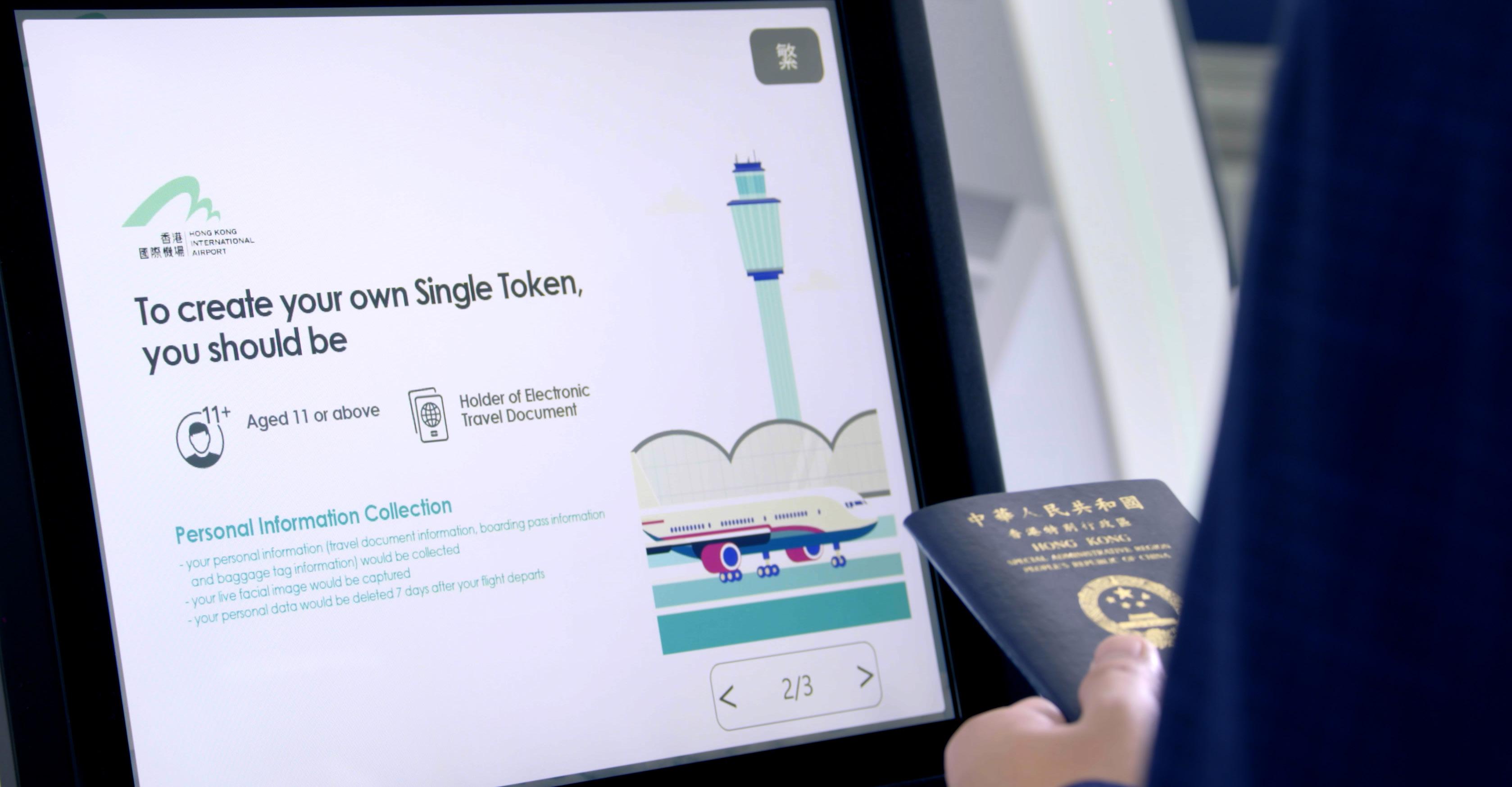
The amount of data that can be aggregated in an airport is enormous. However, when data is siloed in various applications belonging to various stakeholders, it is very hard to make that data work for everyone.
For airports to become insights-driven, the ability to collect and act upon timely and accurate data can be transformational. Benefits include the better matching of airport resources to demand. Collecting data passenger touchpoints accumulated over time makes it easier to create accurate forecasts. Airports can take this a step further by introducing machine learning to analyse the specific behaviour of each flight so they can predict the number of passengers likely to show up, and how many will rely on airport services, like on-site check-in.
Another significant benefit of understanding data insights is the predictive optimisation of baggage handling. It’s now possible to predict baggage delays and misconnections before they happen. Amadeus is already working on a project to offer airlines a complete view of mishandling across their network with AI used to provide
predictions about expected rates of mishandling per route or expected misconnections. If it is apparent that a passenger’s bag can’t make a specific connection in time, then perhaps they should be re-booked on a slightly later flight. These are just a few examples of the value of becoming insights driven.
While one cannot be certain of what it will look like exactly, we do expect certain processes to become obsolete. For example, do we even need to check in at the airport today? The process was initiated in the 1920s to ascertain how many passengers have boarded, or missed a particular flight, helping airlines fill empty seats.
The universal use of smartphones means paper documentation could be eliminated completely one day, ensuring checking-in is completed 100% digitally. Indeed, the majority of passengers check-in remotely today, in many parts of the world. Coupled with the prevalence of self-service technology, including auto bag drops, the space used for airport check-in desks and kiosks could be used much more creatively than it is currently.
More broadly, we expect technology to better integrate with airport design so that passenger services are designed around the needs of the traveler, with technology increasingly ‘shrinking’ and melding into the background.
On the operational side, we are already working to improve how airports can collaborate with partners around disruption. Instead of having to negotiate with airlines to accommodate new schedules and plans when disruption occurs, airport systems should talk to airline systems.
There’s significant scope for automation and better communication channels between airports and airlines that will improve how disruption is handled. Applying modern technology to this challenge is long overdue and we believe it’s one of the most important objectives for the industry over the coming years.
We will also see fully sustainable operations, including a significant percentage of local and regional traffic provided by electric vertical take-off and landing aircraft (eVTOL). Major airlines are making significant investments in this technology, to bring their passengers to their flights in pilotless electric aircraft.





























Esri's global transportation industry director, Terry Bills, explains how the digital transformation of airfield inspections has enhanced safety and operational efficiency at two very different US gateways.
Maintaining the continuous safety of an airport’s runways, taxiways and ramps requires dedicated teams focused on a large number of details.
Each light, pavement marking, navigational aid and airfield sign must be inspected daily, along with pavement inspections to identify any small foreign objects (FOD) that could compromise the safety of planes landing and taking off.
In the US, the daily safety inspection is a Federal Aviation Administration requirement for Part 139 certified airports (ICAO Annex 14 for non-US airports) and requires airports to demonstrate they have adopted programmes to ensure the appropriate safety maintenance procedures for the airfield, including proper record keeping.
Historically, airports used paper processes to document these inspections, and had difficulty turning these paper records into the type of documentation required for FAA certification. In turn, because these were paper forms, many airports struggled to turn an issue found on the airfield into a work order in a timely manner.
Two airports of quite different size – Miami International (MIA) and Rick Husband Amarillo (AMA) – used the time during COVID to focus on their digital transformation efforts, with particular attention on improving overall safety, and specifically airfield inspections, to gain significant efficiencies and improve safety for their airport operations.
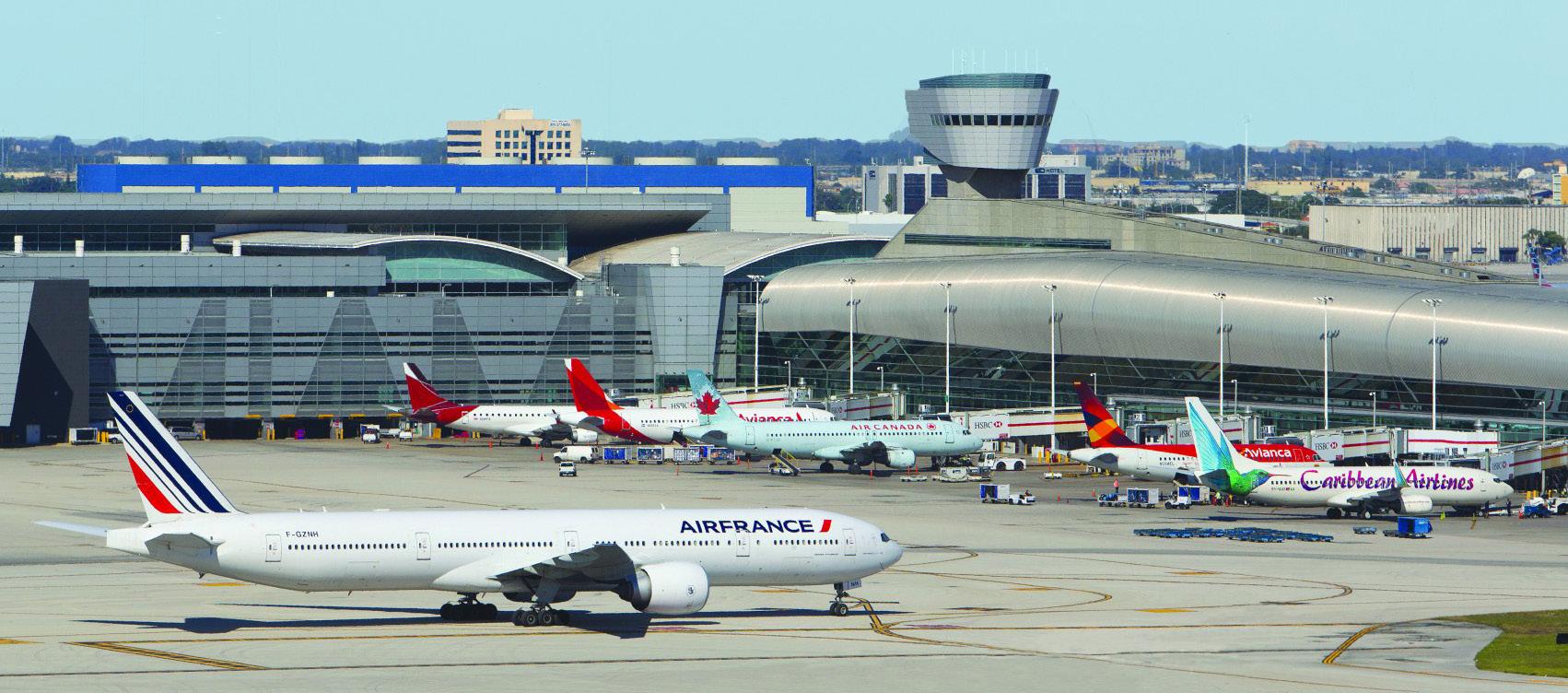
MIA used the time during COVID to adopt an all-digital workflow, replacing a paper-based inspection process with tablets running applications built with geographic information system (GIS) technology.
The applications capture the location of every data entry, use pull-down menus to streamline record keeping, and can append a photo to text descriptions.
Maurice Jenkins, MIA’s division director of information systems and telecommunications, focused on runway safety as a key component of his digital transformation efforts at MIA.
He notes: “We can’t fail, so we make sure to have all the tools and resources available to ensure we rapidly address, respond to, deal with, and mitigate any disruptions in the most efficient and effective manner.”
Before their adoption of Esri’s cloud based mobile technology to perform their daily inspections, Jim Murphy, MIA's head of airfield operations would not see the results of the inspections until the next day. Now, he reports that “the output from this inspection tool allows us to drill down further, focus more, track better.”
And the benefits are not just in speed and efficiency of the inspections, but also accuracy, as Jenkins relates: “It’s clear cut, it’s concise, no one has to worry about deciphering an inspector’s cryptic notes or interpreting what that individual meant when they made that notation.
"There’s no paper to worry about and there’s no wait for someone to input the data. Having a visual representation and seeing everything within a dashboard lets us do better empirical decision-making on-the-fly to improve our operational efficiency.”
Being able to visualise the data captured with Part 139 inspections has been a great help. When the FAA visited MIA for its twice-yearly review of inspections, instead of poring over papers to review inspections, the auditors could view all inspections in ArcGIS Online, look at inspections for any given day, and conduct their review more efficiently.
“Nobody likes having to sit there and read a lot of paper,” says Jenkins. Now the FAA can simply log into MIA’s Part 139 Dashboard, and evaluate the airport’s performance remotely, an approach the FAA is encouraging at other airports.
Rick Husband Amarillo Airport, located in Potter County, Texas, had already been using a digital inspection software solution for some years. While this digital process had been successful, the airport was looking to digitally transform a number of other processes at the airport and wanted to move away from having a series of discrete, standalone software systems.
They were interested in a common platform which could enable better oversight and more ready and harmonious collaboration between different tasks and stakeholders.
Now Geographic Information Systems are providing the ability, in an online, cloud-based form, to bring together safety inspection, safety and asset management, and a number of other functions.
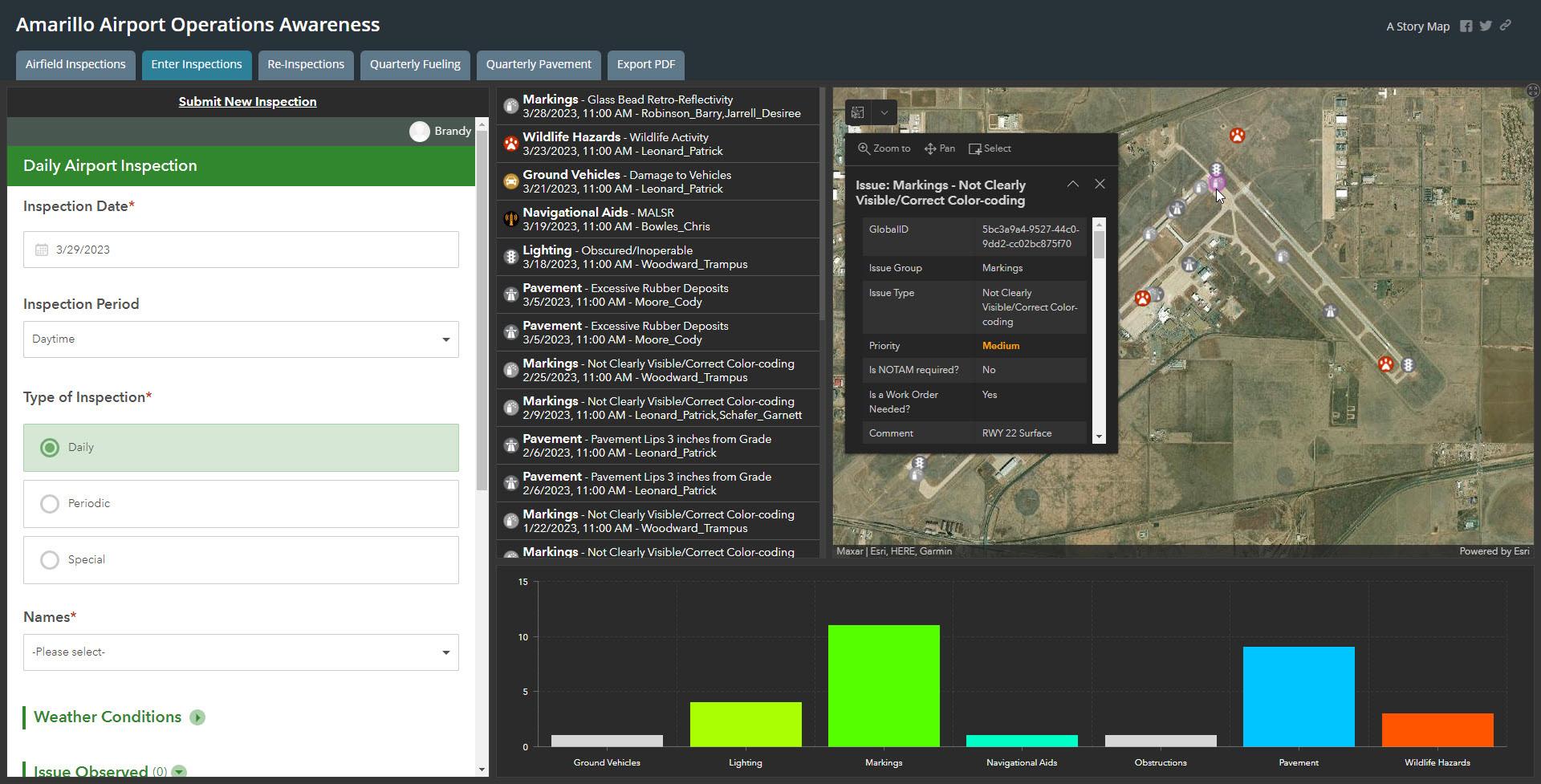
“The centrepiece is hazard identification — having that chain of custody and accountability. The pre-existing software served us well as a first foray into digital inspections, but we were looking for a ‘Swiss Army knife’, rather than lots of separate solutions,” says Thomas Oscarsson, AMA's assistant director of aviation.
Amarillo found gains not just in the efficiency of their inspections, but also in better documentation of the health of their assets.
“What these various inspection programmes do is help to build the safety, environmental and economic cases for investments,” notes Oscarsson.
“Digitisation removes duplication of work orders that might have been written up in different fiscal years or manually stored in different places. Our recent replacement of two taxiways illustrates why that’s important.”
Because the FAA wants to understand an airport’s investments in preventative maintenance before they fund new improvements, Amarillo’s new system will easily give them all of the necessary documentation.
As Oscarsson explains: “GIS facilitates the move from a point solution for inspection to a platform which incorporates asset management information as well as safety management systems.”
Central to that transition for Amarillo Airport was the integration of their airfield inspections with their asset and maintenance management software to further streamline their safety processes.
Now, when a safety inspection identifies a problem, a work order is immediately initiated in the maintenance management system, and the status of the work order is tracked in an Esri dashboard. The completed work order then comes back to the operations staff as a re-inspection task.
The shift from pen-and-paper to apps-and-tablet has been very well received by the operations staff on the ground. By providing a click-through environment, it protects both the individual and the organisation from the consequences of human error.
It also drives further efficiencies. As Oscarsson points out: “We get lots of people coming back and saying, ‘If we can do ‘this’, can we not also do ‘this’? It’s a continual improvement process.”
Consolidation and digitisation of the safety inspections also makes the FAA’s job of auditing much easier as well. “A day taken to trawl through paperwork across multiple on-site locations can be reduced down to an hour or so because everything’s just there," says Oscarsson.
“Because we’re now using a dashboard accessible to the FAA, we’re now instantly inspectable. That makes scheduling easier. It also means that because FAA staff don’t have to spend so much time on the audit itself, they can focus more on other priority areas, too.”
Here again, having an integrated system helps the identification of wider issues which often went unseen in a pen-and-paper setting. Explains Oscarsson: “With a dashboard, you can point, click and filter your way to whatever it is that you wanted to see originally, but also more readily identify trends.”
Amarillo Airport was amazed at how relatively easy the implementation proved to be. There is not a GIS manager or GIS resource at the airport, so they relied on the three way collaboration of Esri, the City of Amarillo’s GIS department, and the airport staff. And since the applications all run on ArcGIS Online, there is not a need for dedicated staff to manage the suite of applications.
And best of all according to Oscarsson; “All this happened across pandemic lockdown without anyone ever meeting face to face.”
While every airport was faced with enormous pressures to cut back budgets and expenditures during COVID, a number of airports took advantage of the quieter times to accelerate their digital transformation efforts.
Key trends for many airport CIOs and IT directors was the desire to consolidate and 'rationalise' their information technology systems into a smaller number of technology platforms to better support key business functions.
This was a continuation of the pre-existing technology trends, but for some airports, with fewer passengers, airport CIOs and senior managers could give their undivided attention to these technology enhancements.
It is clear that for these two airports, the efforts not only paid large dividends in accuracy and efficiency, but also served to greatly increase the operational safety of their airfields.
Radio frequency cyber technology can help combat the dangers posed by the growing number of rogue drones flying close to airports and, in some cases, breaching the perimeter fence, writes Jeffrey
Starr, CMO of D-Fend Solutions.Drone sightings and incidents around airports have increased significantly in recent years. Since the beginning of 2023 alone, there have been serious drone incidents at airports in Edinburgh, Madrid, Palm Beach, and famously, multiple incidents in Dublin.
At Edinburgh, flight departures were disrupted and delayed due to an unauthorised drone near the runway. A drone also caused delays at MadridBarajas Airport when it was spotted by an incoming flight from Paris.
In Palm Beach, a pilot reported a drone right off the side of an aircraft. Flights have also been suspended at least six times since January at Dublin Airport, causing the diversion of flights to other airports.
As drones proliferate, with increased popularity, greater ease of use, and cheaper prices, the likelihood of incidents near airports rises and the risk they pose to airports grows increasingly higher.
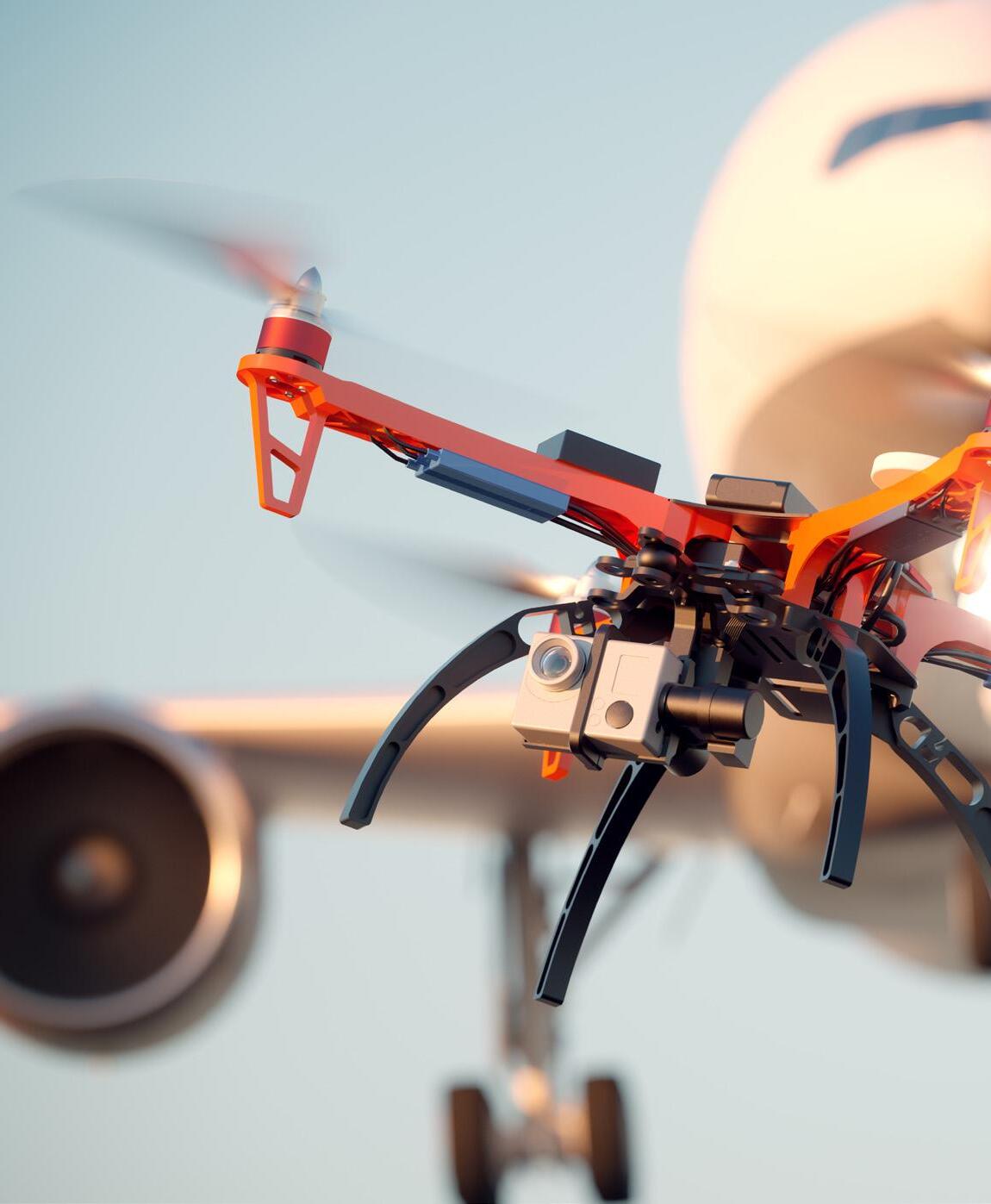
The implications and economic impact are enormous, as reflected in grounded flights, missed connections, angry passengers, and lost revenues.
Indeed, the after-effects of a drone incident can lead to serious consequences and substantial financial costs. Therefore, rogue drones operated by the criminal, careless or clueless create many challenging situations for airports.
Policymakers and regulators around the world have been taking steps to deliver strong messages that operating unauthorised drones near airports is illegal, and could lead to financial penalties, criminal charges, and even imprisonment.
The safety risk is significant. A study from the Canada National Research Council’s Aerospace Research Center showed that common commercial drones with heavy payload capacity can cause serious damage to aircraft, including shattered windshields, penetration and inhalation hazards, lost optics and ultimately may require emergency landings after collision.
Even at slower speeds, such collisions were shown to be able to cause plastic damage and extensive deformation to the skin, as well as additional damage to the aircraft’s internal honeycomb structure.
At higher speeds, collisions were shown as capable of causing severe deformation of slat curvature, damage to the leading edge, and even possible penetration of drone debris into the aircraft’s fractured area.
The drone threat to aviation includes multiple types of dangers. The most obvious is a careless user risking a collision. A bad actor could
want to make an attack. Espionage or surveillance for future incursions is also a risk.
In addition, there are lots of scenarios to consider beyond just everyday aviation. A VIP visit, for example, may pose additional factors requiring extraordinary preparations against a threatening drone.
The risks associated with a drone crashing into a plane, or being used for an attack, has caused many airports to start evaluating options for effective and specialised counter-drone technologies that are suitable for the unique and sensitive environments of an airport
Reaching desired levels of airspace safety in the context of increasing rogue drone activity has proven to be particularly challenging.
Many counter-drone technologies originated from the military realm. They have performed well in the environment for which they were originally designed. However, when they enter the sensitive airspace of a civilian airport, many glaring shortcomings become apparent.
For drone detection, radar has played a role for a long time, but in an airport environment radar may generate false positives from not always being able to clearly distinguish between a drone and other flying objects such as birds.
Optical systems require a clear line of sight, which can be difficult in urban environments or hilly terrain. Acoustic methods are challenged by noisy airport environments and increasingly quiet drones.
Radio frequency (RF) based methods such as directional finders may not be able to locate and track the drone to the highest degree of precision.
The challenges are even more steep when considering mitigation, especially when again looking at countermeasures that came from the military sector.
Jamming could be prohibitively problematic to a sensitive airport environment, given the possibility for disruption to communications and operations. It’s also temporary by nature, and the rogue drone pilot could regain control when jamming ceases.
Any type of kinetic, that is physical mitigation method involving shooting some sort of projectile at the drone, carries with it the serious risk of collateral damage, either from the projectile itself or the downed drone and resulting debris.
It’s become increasingly clear that sensitive airport environments would benefit most from a safe and innovative defense against rogue drones. Technology should also conform and evolve with current regulations and be future-ready as regulations rapidly evolve to confront the recognised threat.
An ideal solution could encompass both passive detection to raises the airport’s situational awareness, with a migration path to eventually extend to also include full, seamless, and simple mitigation capabilities, as policies and regulations permit.
A new generation counter-drone technology, RF cyber, is showing promising results for airports for both detection and mitigation. An RF cyber-detection solution facilitates agility, enabling airport security personnel to quickly adapt.
Unlike the legacy anti-drone technologies, cyber-detection detects and tracks both authorised drones and rogue drone threats, providing situational awareness along with a rich set of capabilities, including tracking drone location, home location, and drone operator location, accurately and in real-time.
Airport security staff can then choose how to utilise the information to contend with the risk and achieve optimal operational continuity.
When permitted by local regulations and policies, and performed by authorised security agency staff, RF-cyber takeover mitigation capabilities can be activated.
Detecting and, when permitted, mitigating the rogue drone threat quickly and efficiently can help maintain safe airport operations. Such a system could assert control over rogue drones and land them safely in a designated zone, as allowed by regulations and performed by the authorized personnel.
Airports could be empowered to detect threats without excessive burden on human resources, disrupting communications systems, or damaging existing infrastructure.
The system would understand the unique identifiers of each drone. Once a drone is classified as 'authorised', it would be labelled as such and be allowed to fly undisturbed in defined areas. The ability to distinguish between authorised and unauthorised drones would ensure continuity for drones performing essential functions at the airport.
The cyber counter-drone system must include stationary configurations specially designed for the unique requirements of airports, with enough long-range coverage for airport deployments to protect the airports’ airspace.

The sensors must protect the approaching and take-off air corridors. The hardware should be designed to withstand any extreme environmental conditions of the airport’s location.
Airport security, safety and continuity would be further facilitated by preventing the drone pilot from regaining control over the hostile or rogue drone, thereby smoothly mitigating the threat.
Airport authorities could receive preventative alerts while providing crucial data – such as drone take-off and pilot remote control locations, so authorities can deal with specific flights and dispatch appropriate personnel.
Airports rely on uninterrupted operations. A new generation of RF cyber detection and mitigation technology could help assure that airport operations continue to run as usual. Continuity prevails as flights, communications, security and everyday life in the protected airport area proceed smoothly.
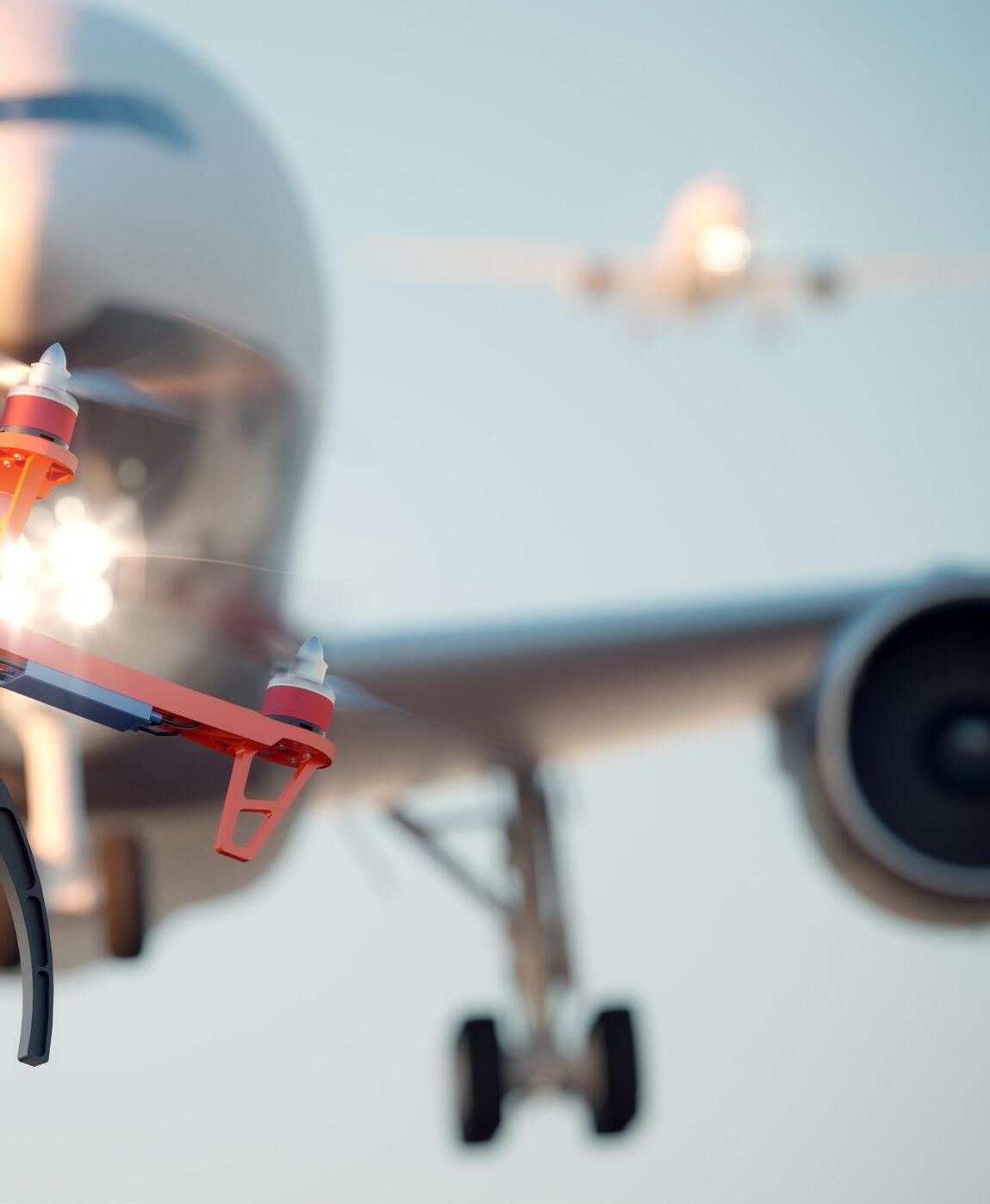
We pay tribute to ACI World's 2022 Airport Service Quality (ASQ) Award winners whose customer service excellence continues to enhance the airport experience for passengers.
Airports big and small across the world have been recognised for their customer service excellence throughout 2022 in ACI’s annual Airport Service Quality (ASQ) awards.
Winners ranged from the big hubs of Istanbul (IST) and Rome-Fiumicino (FCO) in Europe; Hartsfield-Jackson Atlanta (ATL) and San Francisco (SFO) in North America; Singapore Changi (SIN) and Delhi (DEL) in Asia-Pacific to some of the world’s smaller gateways, such as Guanacaste (LIR) in Costa Rica and Salalah (SLL) in Oman.
In Africa, Casablanca Mohammed V International Airport (CMN) tasted success in the 5-15mppa category; Blaise Diagne International Airport (DSS) in Senegal and SSR International Airport (MRU) in Mauritious couldn’t be separated in the 2-5mppa section; and Moi International Airport (MBA) in Mombasa, Kenya, won the Under 2mppa Award.
The winners were also pretty straightforward in the Middle East, Salalah (SLL) in Oman, Queen Alia (AMM) in Jordan, and Oman's Muscat International Airport (MCT) winning in the Under 2mppa, 5-15mppa and 15-25mppa categories respectively.
Speaking about the success of Queen Alia, which also scooped the 'Most Enjoyable Airport' Award for the Middle East, Airport International Group's CEO, Nicolas Claude, said: “Since the terminal building’s inauguration 10 years ago, we have been keen to listen carefully to the evolving needs and expectations of our passengers so
that we may create a welcoming atmosphere that makes them feel at home, deliver a memorable customer experience and ensure a lasting positive impression of Jordan’s prime gateway to the world.
"We are privileged that the efforts of the entire airport community have been acknowledged by those who matter most – our passengers – whom we thank once again for choosing us as one of the best airports for customer experience worldwide. Congratulations to our teams, partners and stakeholders on these fantastic wins.”
It proved much harder to split the winners across Asia-Pacific, Europe, Latin-America-Caribbean and North America in the Best by Size categories, with multiple winners for most awards.
The winners included China's Beijing Daxing (PKX) and Gimpo (GMP) in Seoul, South Korea, sharing the 25-40mppa Award for the Asia-Pacific region; Alicante (ALC), Budapest (BUD) and Helsinki (HEL) doing likewise in Europe's 15-25mppa category; while in North America, Detroit Metropolitan Wayne County Airport (DTW) and Minneapolis/St Paul (MSP) jointly won the 25-40mppa Award and Dallas/Fort Worth (DFW) and San Francisco (SFO) did the same in the Over 40mppa category.
Singapore Changi, which was one of six airports to finish joint top in Over 40mppa category for Asia-Pacific, recently introduced a rock climbing wall (pictured left above) as one of its attractions.

Commenting on the ASQ success of Budapest Airport, CEO, Chris Dinsdale, said: “Winning this prestigious award is a truly proud moment for all at Budapest Airport. The customer is at the centre of

everything we do. We actively listen to our passengers and ensure we evolve with our approach to their needs and expectations. The travel experience starts at the airport and we are exceptionally honoured to be a role model in the global aviation industry.”
Talking about Helsinki's accolade, Finavia CEO, Kimmo Mäki, enthused: “We are delighted to have won the award and are proud that air passengers have chosen Helsinki Airport as the best airport in Europe. Year after year, Helsinki Airport continues to be ranked among the best airports in the world.
“We have designed and built Helsinki Airport and its renewed terminal for the air passengers. We believe that we have succeeded in developing an airport that serves the needs of different passengers in a versatile manner and improves the smoothness of travel."
In addition to the ASQ award, Finavia was inducted into ACI World Director General's Roll of Excellence for providing outstanding customer service over a five year period.
Maki added: “I would like to thank everyone at Finavia and all the companies and personnel operating at the airport for this fine achievement as well as the great customer service work that everyone working at the airport has committed to. A successful customer experience can only be created by working together."
In the US, Wayne County Airport Authority CEO, Chad Newton, once again attributed DTW's ASQ success down to the dedication and hard work of airport staff.
"Our entire team at Detroit Metropolitan Airport is responsible for DTW receiving this honour, our third ASQ Award since 2018,” said Newton.
“We’ve listened to customer feedback and developed action plans for improvement. Everyone played a role, including our airport authority staff, airlines, janitorial staff, Customs & Border Protection, TSA, concessionaires, and more. It’s encouraging to know our customers have noticed our efforts. We are grateful and remain dedicated to exceeding expectations at DTW.”
Thinking along the same lines, SFO's airport director, Ivan Satero, commented: “We are truly honoured to be ranked by passengers as the top airport in North America in the ACI Airport Service Quality programme.
“Combined with our ranking as the top US airport by the readers of the Wall Street Journal, this latest award validates the hard work our team has put forth to create the world-class airport experience our customers truly appreciate and deserve.”

From over 465,000 surveys collected in 2022, 144 awards have been won by 75 airports around the world. The awards categories include the perennial Best Airports by Size and Region, as well as new categories introduced this year to reflect the evolution of passenger needs:

• Airport with the Most Dedicated Staff
• Easiest Airport Journey
• Most Enjoyable Airport
• Cleanest Airport
Across all the award categories, nine Indonesian Airports won ASQ Awards, with Sultan Hasanuddin International Airport (UPG) winning five of the six categories it entered.
China (6 airports) India (6 airports), Malaysia (2) and Oman (2) also performed exceptionally well in the ASQ programme.
The region's winners included Bengaluru's Kempegowda International Airport (BLR), which continued its success in the Best Airports at Arrivals Globally category, sharing the honour with Abu Dhabi International Airport (AUH) and Hartsfield-Jackson Atlanta International Airport (ATL).
Kempegowda operator, BIAL, believes that factors such as its efficient deboarding procedures, streamlined immigration and customs processes, organised baggage claim services and the availability of infrastructure such as transit hotels and AI-powered assistance robots, ensure a smooth arrivals experience.
BIAL's managing director and CEO, Hari Marar, enthused: "We are truly honoured to receive the Best Airport at ACI's ASQ Arrival Survey Globally for the year 2022. This recognition comes as a testament to the hard work, dedication and commitment put forth by our team.
"We would like to thank the government authorities – Immigration, Customs and CISF – and the Airport Authority of India for their co-operation in enabling a seamless arrival process.
"We would also like to thank our passengers for their unwavering trust and confidence in us. This award further motivates us to continue to strive towards excellence and reinforce our position as one of the leading airports."
In addition to the other awards, five new airports were inducted into the Director General’s Roll of Excellence, which honours airports that have won multiple awards in the ASQ programme over a five-year plus period.
The new additions are I Gusti Ngurah Rai Airport (Bali, Indonesia); Helsinki Airport; (Helsinki, Finland); Guanacaste Airport (Liberia, Costa Rica); Quito International Airport (Quito, Ecuador); and Tallinn Airport (Tallinn, Estonia).
ACI World director general, Luis Felipe de Oliveira, said: “The passenger is the centre of everything, and this is reflected in every aspect of the Airport Service Quality (ASQ) programme.
“Travellers have spoken and recognised the successful efforts of these airport communities in providing outstanding customer experience. Congratulations to the best airports for customer experience worldwide.”
He noted: “The ASQ programme not only measures and benchmarks, but also provides airports of all sizes with an
opportunity for continual learning and improvement to reach new heights in customer experience excellence.
“The new categories not only reflect the growth of the programme but also the evolution of passenger needs. It is a non-negotiable – airports must listen closely to the voice of customers so we can continue to serve people and communities in a sustainable and resilient way. This is the way forward.”
Unlike other customer experience and benchmarking awards, the Amadeus sponsored ASQ programme is based on live research via surveys gathered at the airport — direct from the traveller — rating their satisfaction on the day of travel.
The survey covers over 30 performance indicators across key elements of the passenger’s airport experience such as ease of finding your way, check-in and the shopping and dining offerings. This gives the most complete picture of the passenger experience journey at each airport and provides global benchmarks for the industry. Last year, more than half of the world’s travellers passed through an ASQ airport.
Elena Avila, Amadeus’ EVP of airport IT and airline operations, said: “Passengers are the backbone of travel, and that’s exactly why we are thrilled to once again support ACI’s ASQ programme.
“The awards rightly celebrate airports striving to make positive changes in the face of challenges impacting our industry. Underpinned by closer collaboration between all stakeholders, we recognise modern technologies such as data analytics, biometrics, and the cloud are key to transforming the passenger experience.
“We at Amadeus look forward to supporting our airport customers to continue pushing passenger experience boundaries.”
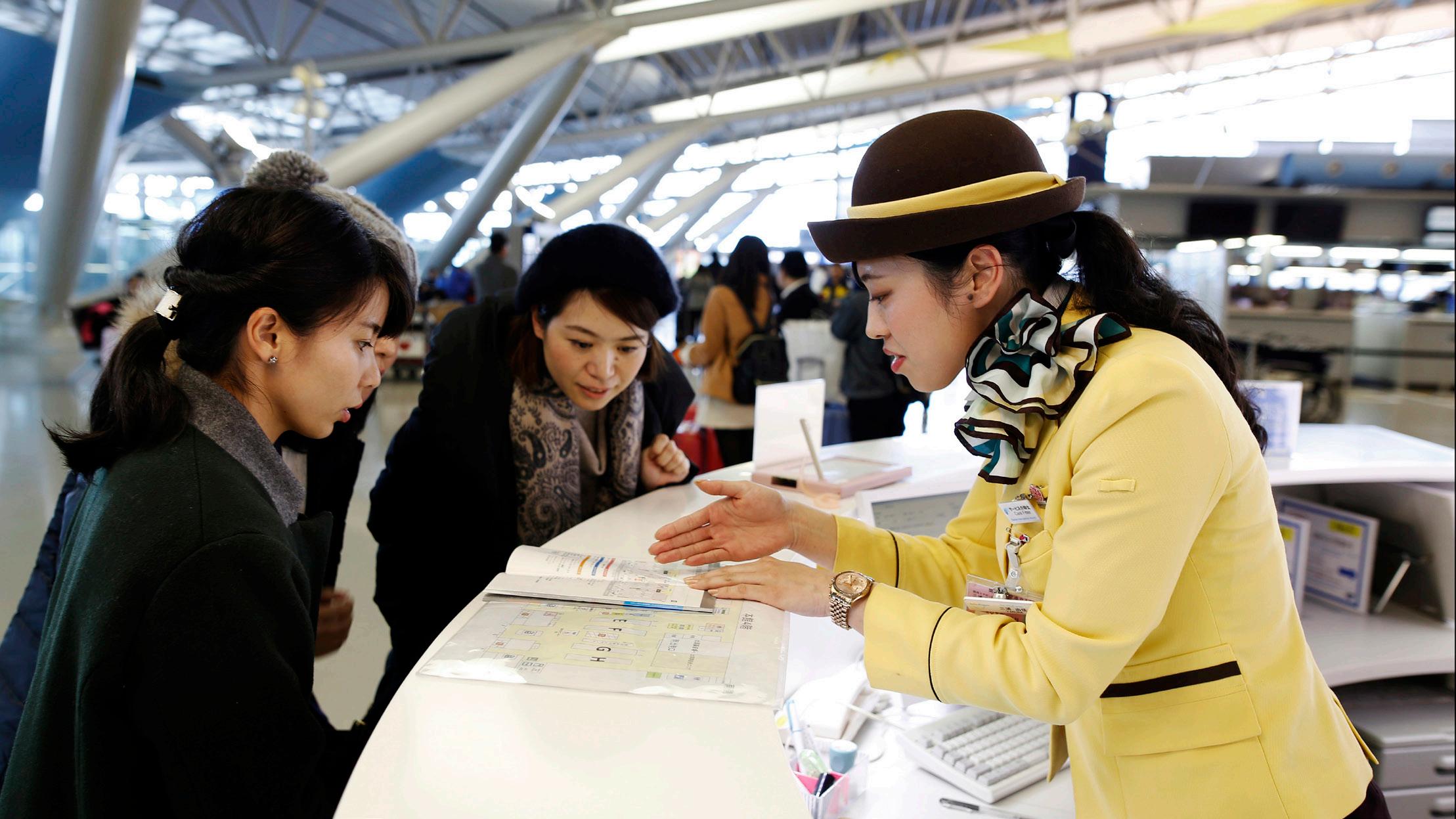
The awards will be officially handed over to the winning airports during a ceremony at ACI’s Customer Experience Global Summit in Incheon, South Korea, this September (4-7).
Click the link ASQ Awards and Recognition to see the full list of ASQ Award Winners. AW

Kevin Cox, CEO of Ferrovial Vertiports, considers the key role airports can play in unlocking the benefits of urban air mobility.
The revolution in Urban Air Mobility is gathering momentum globally with a new model of sustainable transport set to become reality within a few years. Electric vertical take-off and landing aircraft (eVTOLs) will transform the way we travel within and between cities.
The design and development of eVTOLs is moving apace as developers seek certification for these battery-powered aircraft from aviation regulatory authorities.
Indeed, several manufacturers expect regulatory approval for manufacturing and operations between 2024 and 2026.
Hand-in-hand with eVTOL development is the need for a network of sites for these vehicles to take-off and land. These sites are known as 'vertiports' and infrastructure companies around the world, including Ferrovial, are analysing the most effective markets, locations and facilities to maximise the benefits of eVTOL travel.

It’s critical that airports understand and actively engage with this new transport mode which will bring benefits to them, their airline customers and passengers, and local communities.
Tapping into this new market can improve airports’ connectivity locally, provide a faster travel alternative and open up routes to airlines and new passengers, while lessening the overall environmental impact. Already, airlines across the world are embracing the potential of eVTOLs with aircraft orders and/or partnerships.
There are currently three main business models which eVTOL service operators are focusing on, and the most effective vertiport networks will need to be agnostic to support all of them.
Each vertiport site location will be chosen based on local market demand, demographics, topography and climate. Complex analysis of potential sites will also consider existing transport options and trends as well as airspace availability.
The first business model is intra-city, which will serve commuters travelling across large cities and their surrounding neighbourhoods on short routes of up to 50 kilometres.
This model demands high frequency operations, albeit with peaks and troughs during the day and week as with traditional commuter travel. A dense network of vertiports will be required to support these services with excellent connections and integration with rail and other transit modes.
The vertiports will need to be located close to residential and business areas as well as leisure and cultural centres and transport intersections such as cruise ship hubs and airports. Airports and airlines can benefit from this model by feeding intra-city traffic onto traditional flights.
The intra-airline model is point-to-airline travel of up to 150 kilometres. This would offer passengers significantly reduced journey times, such as between an airport hub and metropolitan area not served by traditional air-service operations.
To maximise these quicker journey times, vertiports need to have excellent connections with other local and regional transport modes. These links would generate additional traffic for the airport and airlines and open up new travel options for passengers.
Finally, the inter-city model offers routes between 50 to 300 kilometres benefitting passengers with considerable time savings where there are no existing connections by air or other transport modes.
This model will also require excellent integration with local and regional transport modes to support passengers’ connectivity choices. It is anticipated that inter-city traffic will have more weekly rather than daily variability in customer demand.
Over time, these eVTOL trips are expected to be as affordable on a per-mile basis as app-based and private car services.
Vertiport networks will bring new benefits to airports and airlines. They will enhance local and regional air connections and generate additional traffic for airlines while being quieter than many other transport types and creating zero emissions.
Access to traditional airports is likely to play a key role in the success of this new industry, but just having available land is not enough. UAM passengers will want speedy connections to get to their final destinations seamlessly, so vertiports throughout an urban market need to be located where people live, work and play.
In contrast to airports, which tend to be built outside metropolitan areas due to land requirements and noise levels, vertiports will need to offer convenient first and last-mile connections.
Fortunately, vertiports can be built almost anywhere including at or near airports. They will be small, unobtrusive and embedded into the local community since eVTOLs don’t need a runway or a large footprint.
Those airports and airlines that are keen to embed a vertiport into their business need to consider various factors.
Firstly, will it benefit their market? Does an airport want a vertiport largely to support its current customer base and continue to locally feed its existing hub more efficiently? Does it want to generate new passengers such as point-to-point city commuters from other markets? Is it a combination?
Secondly, what are the practical requirements? How much land is needed, is local airspace compatible to eVTOL operations and what are the additional security measures required?
In terms of size, large eight-stand vertiports may cover approximately 13,000 square metres while a small two-stand vertiport needs just 4,000 square metres, including buildings and airfield.
It’s not just space that’s critical but good connections to surface access are also essential. Other considerations include whether the
vertiport should be located on the airport site, and, if so, airside or landside or outside the perimeter.
Each option will present operational and connectivity opportunities and challenges to be worked through.
Vertiports offer an opportunity to re-design air travel by simplifying check-in and security procedures and reducing passengers’ dwell times. Operators are aiming for passenger waits of 15 minutes or less with quick kerb to airside access.
Speed is also key for aircraft turnaround times. eVTOL flights will only be effective if they operate at high frequency with minimal turnaround times for battery charging and maintenance.
It’s critical that vertiports are agnostic and able to serve various eVTOL sizes and business models. This will maximise traffic flows and optimise operational efficiency and space. And it must provide fast, convenient connections that are critical to UAM’s success.
The third factor to be considered is how vertiports will benefit local communities and meet their expectations on safety and sustainability, including noise levels. Obviously, safety in the air and on the ground remains the number one priority but sustainability will be key, too.
Both vertiport operations and eVTOL flights must target zero-carbon goals, be quieter than traditional aviation operations and rely on renewable energy when possible. In short, vertiports must be good neighbours.
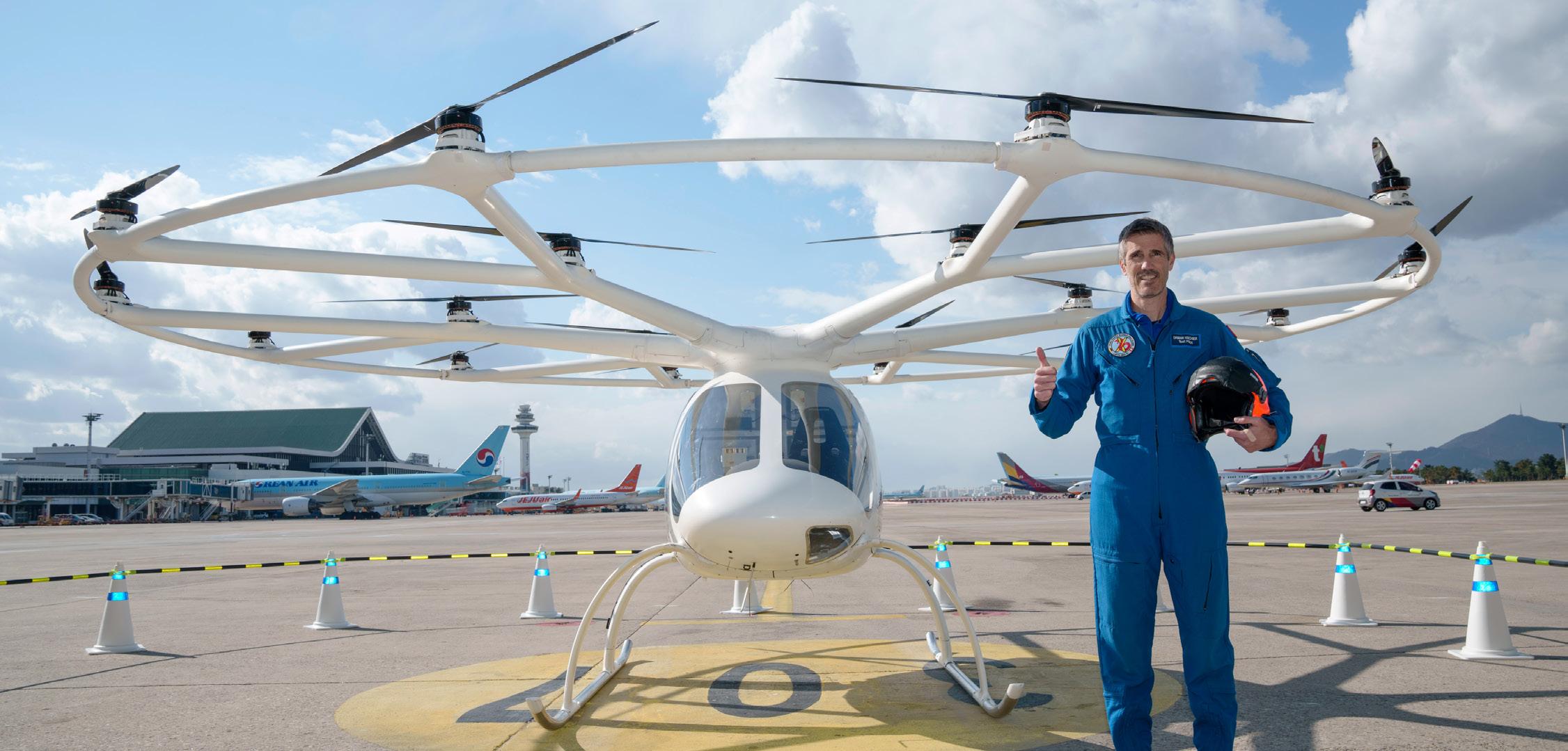
We are at the dawn of a new era in urban mobility. eVTOLs and vertiports will provide safe, quiet and environmentally friendly travel that integrates into existing infrastructure including airports. It will enhance local and regional travel, boost local economies and provide new routes for commuters and also for business and leisure travellers.
The revolution is happening right now. Various eVTOL models and vertiports are being developed that will transform the way we move while reassuring consumers that they are safe, sustainable and offer value for money.
In summary, airports and airlines have a critical role to play in this new aviation market. Those airports and airlines that are already working alongside eVTOL and vertiport developers will be well positioned to benefit from this innovative, ground-breaking transport mode when it takes off.
Airport World reports on the planning, design and opening of Kansas City International Airport's new $1.5 billion terminal.
After five years of development, design and construction, the new 40-gate terminal at Kansas City International Airport (KCI) has opened for business, ushering in a new era of air travel for the region.
At 1.1 million-square-foot and built at a cost $1.5 billion, the new terminal is the largest single infrastructure project in the city's history and was delivered ahead of schedule and on budget while providing a significant economic boon to the local community.
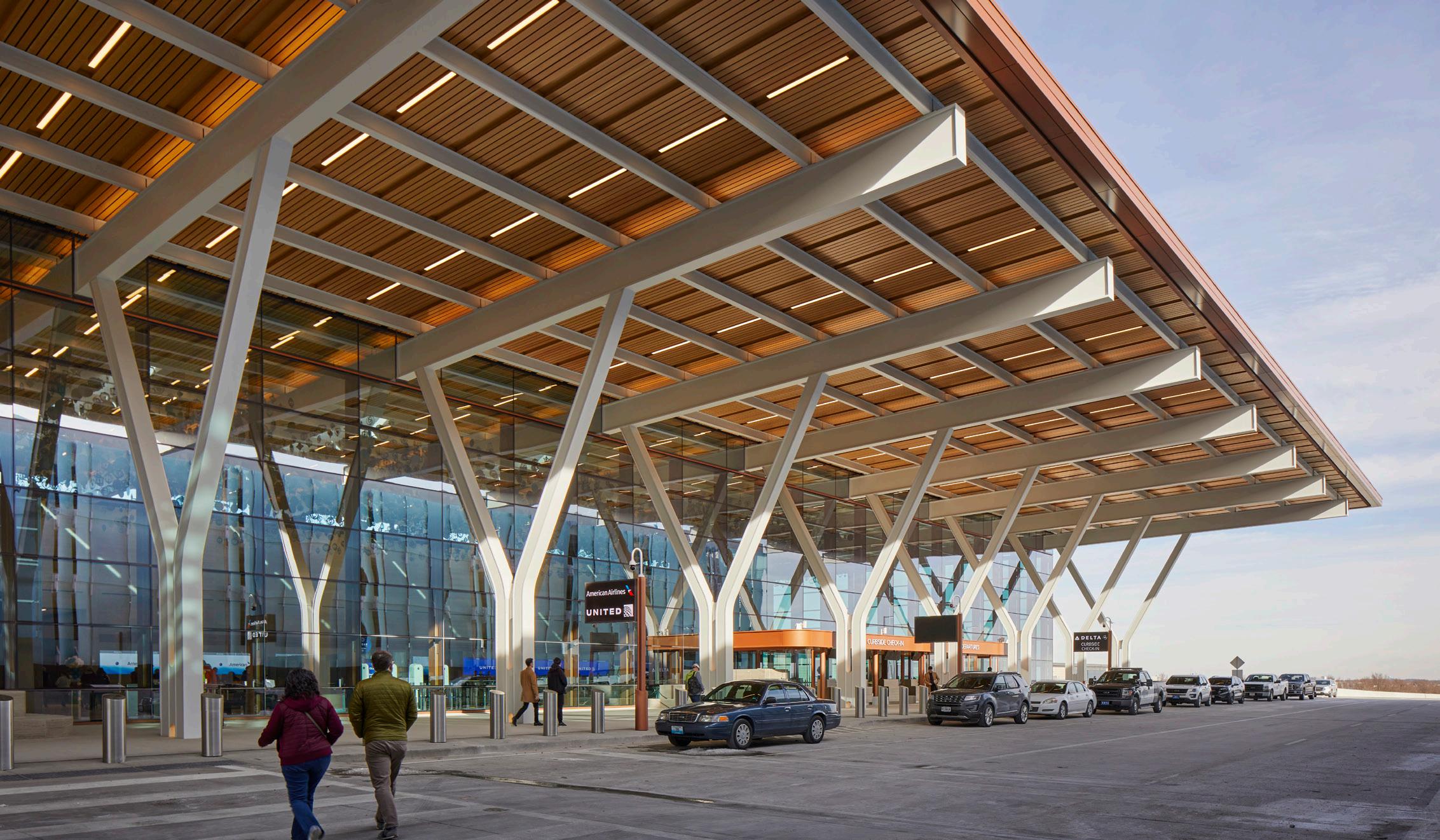
The new two-level facility, which can be expanded to a 50-gate facility in the future, wholly replaces Kansas City’s former terminal buildings and is located next to a new 6,200-space parking structure to provide a seamless transition from parking to gate.
Designed to showcase Kansas City’s authentic culture and heart, the new terminal features nearly 50 local and global dining and shopping experiences with 80% of the brands represented from the Kansas City region.
The new terminal’s facilities include the Kansas City Air Travel Experience (an airplane simulation room for anxious, first-time travellers or individuals with a fear of flying), a sensory room, quiet room, indoor and outdoor pet relief areas, the Variety KC Inclusive Family Play Zone, and glass boarding bridges to increase natural light, views of the airfield, and reduce flight anxiety.
It also boasts three times as many toilet fixtures post-security as the current terminals, with options including gender-neutral restrooms and family restrooms with adult changing tables.
Another promiment feature is $5.6 million of newly commissioned art, showcased through 28 unique installations, 19 of which were created by
artists who live in, or have ties to, the Kansas City area. The project is the largest One Percent for Art programme in Kansas City history.
“This terminal is a new front door to the people of Kansas City, to everyone in our region, in Missouri and Kansas," enthused Kansas City mayor, Quinton Lucas.
“Because of this project, thousands of Missourians and Kansans have gotten jobs and built new careers. Because of this project we will bring millions, if not billions, of dollars in new economic development to Missouri and Kansas. Because of this project we will build generations more of exceptional memories here at KCI. This project is because of you.”
Developed by Edgemoor Infrastructure & Real Estate and constructed by CWC – joint venture team comprising Clark Construction Group, Weitz Construction Company and Clarkson Construction Company – the new terminal has transformed the Missouri gateway.
The Edgemoor/CWC team, along with the Kansas City Aviation Department (KCAD), and project designer, Skidmore, Owings & Merrill (SOM), note that they prioritised community engagement from the project’s outset, hosting hundreds of project presentations and dozens of community design workshops and open house sessions to inform the community about the project and solicit their input on the new terminal’s design and amenities.
The result, they say, is a modern, convenient, sustainable, and inclusive facility that is uniquely Kansas City and meets the diverse needs of travellers in the region.
“This project is a testament to the hard work and dedication of our project management team and trusted trade partners, as well as the ongoing support of the Kansas City community,” said Mark Goodwin, vice president with Clark Construction and project director in charge of the new terminal’s design and construction.
“The input from the community, and meaningful contributions of hundreds of Kansas City-based firms, helped ensure the project will have a lasting positive impact on residents, and on the business community.”
More than 240 Kansas City-area firms contributed to the project, which generated over 6,500 design and construction-related jobs.
Lead engineer, Henderson Engineers, designed an all-electric power system for airport operations that is said to place the terminal at the forefront of sustainability.
Compared to a traditional mixed fuel system that uses natural gas, oil or coal, the all-electric system is expected to avoid 92% of operational CO2 emissions by 2050.
With the airport’s new 6,219-capacity parking garage a complement to the oversize vehicle/surface parking, Henderson provided specifications and design for 70 electric vehicle charging stations.
Additionally, the Henderson engineering team’s custom-designed electrical infrastructure within the parking garage provided flexibility for the integration of a 510-panel solar array, designed and provided by Good Energy Solutions, and supporting an inductive bus charging system, a first-of-its-kind at a municipal international airport.
Much like wireless phone charging, MCI’s fleet of electric buses simply park above inductive charging pads to power up while picking up travellers.
“Because we knew this facility will be in use for at least the next five decades, we were focused on its long-term success and viability,” said James Dietz, principal and aviation practice director at Henderson Engineers.
“As aviation continues to adopt sustainable design practices, going all-electric future proofs the project from taking on considerable upgrades down the road. It’s good for the planet, and good for the wallet.”
In addition to meeting the city’s goals for accessibility, inclusivity, and diverse participation, the new terminal is also among the most sustainable airport facilities in the US.

The project, for example, recently achieved LEED Gold certification, making it the first LEED v4 Gold BD+C: NC terminal/concourse project in the Midwest, and the second in the United States.
Sustainable features include locally sourced materials, electric charging stations for personal and commercial vehicles, smart building systems, efficient lighting, and improved air quality.
“Throughout this project, we’ve focused on investing in the economic growth of women and minority-owned businesses, while providing a state-of-the-art new terminal that will redefine standards for air travel,” said Geoff Stricker, Edgemoor's senior managing director.
“Kansas City is experiencing an exciting period of growth. We are honoured to have delivered this transformative project to meet the evolving needs of the region.”
The airport believes that its uniquely Kansas City-inspired concessions programme, created by Vantage Airport Group, features the best of the city’s beloved flavours, makers, history, and experiences delivered by local partners.
Indeed, Vantage is confident that it has set a new industry benchmark for local and minority participation after partnering with minority equity partners Parson + Associates and RMD Holdings, and prime concession operators Outstanding Hospitality Management Concession Group, a Missouri based food and beverage business, and global airport retailer, Marshall Retail Group.
“I want to thank Vantage Airport Group and every stakeholder that had a piece of this project in the last ten years,” enthused KCAD's director of aviation, Pat Klein.
“Vantage’s concession programme will provide the highest level in customer service and amenities and convey a sense of place in the Kansas City region as we open the new front door to our community for Kansas Citians and our visitors.”

Distributed throughout the new terminal across its two concourses, the concession programme nearly doubles the former offerings. From the moment incoming and departing passengers arrive at the new MCI, they can enjoy regionally inspired dining, shopping, and experiences that are unmistakably made of and by Kansas City.
Unique concepts and locations named after neighbourhoods and cultural institutions elevate the travel experience, says the airport.
Two food halls feature outposts of popular local KC restaurants such as Bloom Baking Company, Bo Lings, and Parisi Coffee. Made in Kansas City Marketplace, an immersive retail destination, offers a curated collection of locally crafted goods, gifts, and apparel from KC makers and retailers including Charlie Hustle and Christopher Elbow Chocolates.
Other notable local brands now open in the new terminal include Brown & Loe, Meat Mitch, and Messenger Coffee, while Kansas City’s burgeoning craft brewery scene is well-represented in the new terminal, with Boulevard Brewing Co, Martin City Brewing Co, and Stockyards Brewing Co.
Entertainment stages have been incorporated seamlessly into dining spaces throughout the new terminal, including a performance stage adjacent to Soiree Steak & Seafood House, in collaboration with the American Jazz Museum. In the Made of Kansas City Food Hall, the Jay 'Hootie' McShann’s Blues Bar pays homage to this iconic KC musician.
For legions of longtime and new Kansas City barbeque fans, the KC Barbeque Experience is another focal point of the new concession programme. This expansive dining, shopping, and performance space offers authentic KC BBQ fare prepared by Smoke & Magic, the inaugural champion of the programme’s annual pitmaster competition, which earned a one-year license to operate at MCI along with a cash prize.
Global brands rounding out the commercial offer include &Go, Auntie Anne’s, Big Chicken, Cinnabon, Dunkin’, InMotion, Johnston & Murphy, Lego, and Smoothie King.
New parking garage
Covering over two million square feet, KCI's new seven-storey parking garage features what has been described as an "elegant and functional parking façade" from Bendheim.
Kansas City-based firm BNIM took lead on the parking facility, in a design-build partnership with general contractor JE Dunn.
Bendheim joined this effort from the design stage, collaborating with their partner Längle Glas to create custom-engineered fastening systems for the parking facility’s ventilated façade. Bendheim ultimately provided over 50,000 square feet of tempered and laminated glass for the project.
At KCI, Bendheim notes that the 'shingled' design of the façade creates pockets of air that slide between the glass panels, creating airflow in and out of the garage.
The sheer size and weight of the glass panels, most as large as 6ft x 14ft and each weighing 800+ pounds, called for a carefully designed attachment system. Bendheim and Längle designed and manufactured custom vertical compression clip systems for the project, allowing a costly steel substructure to be eliminated from the design. The 14” long clips support the length and weight of each panel while accommodating construction tolerances, live load movement, wind loads, and expansion joints.
Bendheim and Längle say they deliberately kept ease of installation at the forefront of their design process. “We were very impressed with the Bendheim system, which was designed very well, and the installation of the system and the glazing was a breeze," commented Paul Fischer, project manager and field foreman at AGP, Inc.
“We were extremely proud to bring our understanding of glass and our extensive experience with ventilated parking façades to this historic undertaking,” noted Bendheim’s Said Elieh. AW
US$3,000 | Table top booth – includes 2 conference passes

Blueprint Power's chief technology officer, Nick Schmidt, considers some of the energy monitoring and emissions reducing options open to airports at the beginning of their decarbionisation journeys.
Governments and organisations around the world are grappling with energy and sustainability challenges as they try to lessen their environmental impact and support global climate goals and airports, of course, are not immune to these challenges.
In fact, in 2021, the aviation sector accounted for more than 2% of global greenhouse gas emissions. To put that in context, as one report indicates, if the aviation industry were ranked alongside countries, it would be sixth in the world for emissions.
With these numbers in mind, airports across the globe have made commitments to sustainability goals and are taking forward-thinking steps to achieve them, many being recognised by ACI's Airport Carbon Accreditation programme.
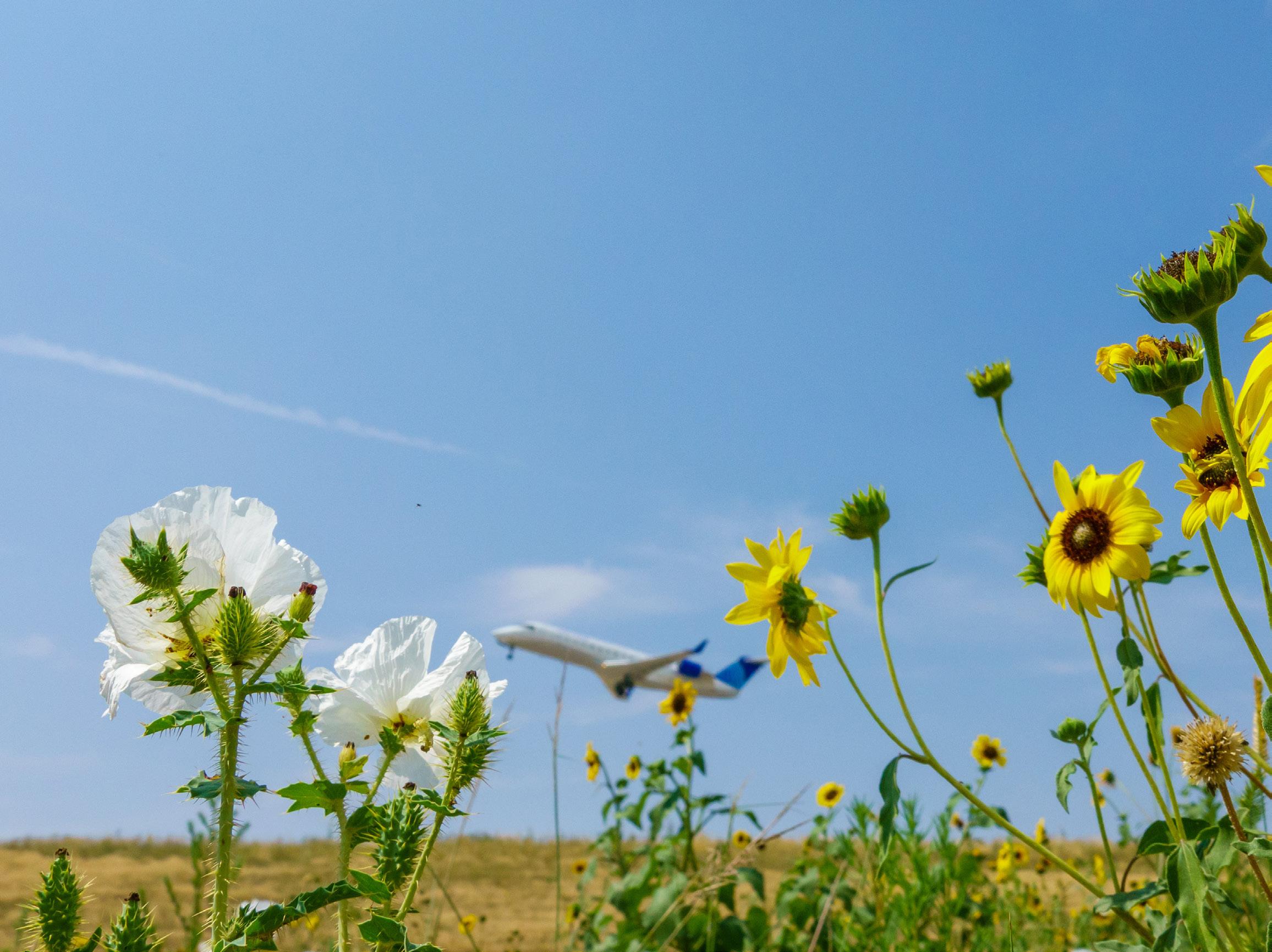
The examples of airport innovation when it comes to reducing their carbon footprint are numerous, and it is obviously impossible to highlight them all. However, in this article, I would like to highlight the work of several gateways.
Stockholm Arlanda Airport, for example, uses an aquifer as an energy storage unit, and is gradually replacing its vehicle fleet with electric vehicles (EVs).
In the United States, Denver International Airport has the largest existing solar power farm at a commercial airport in the country. Meanwhile, Zurich Airport, Delhi Indira Gandhi International Airport and Singapore Changi Airport have all set net-zero or carbon neutrality goals and have made progress on achieving those goals.
Nevertheless, for many airports, knowing where to start the decarbonisation process may be one of the biggest hurdles they face.
The first thing that likely comes to mind when we talk about greenhouse gases at an airport are the planes themselves, but they are not the only source of emissions – the buildings and fleets on the ground also play a role.
In fact, in order to truly align with sustainability goals, a dual path approach – addressing emissions on the ground and in the air, separately, may be the most efficient, and most transparent, way to decarbonise.
Additionally, airports need detailed, trustworthy energy consumption data about their energy use volumes, patterns and impacting factors such as whether to adequately baseline current operations, appropriately size new clean energy solutions and measure and report on progress in the future.
This can be accomplished with hardware, such as Blueprint Power’s DIGBOX, installed onsite to ingest and organise data in real time, and energy modelling, giving airports a 360-degree view into energy performance and how to best optimise it.
One productive approach to reducing emissions from ground operations is energy usage optimisation. This leverages the data collected onsite to identify consumption volumes and patterns of various energy 'consumers', such as building systems, tenants, or fleets.
With this knowledge, airports may be able to change the patterns of how energy is used. They can then reduce consumption, particularly at peak times, and lower emissions and costs. Other on the ground solutions include:
– Building electrification
Replaces inefficient assets, such as converting to LED lighting or switching to electrified heat pumps.
– Adding submetering
Gives a more granular view of how much energy is consumed and by whom, which makes it easier for airport stakeholders to measure and manage.
– Onsite renewable power generation
Provides clean, onsite energy generation, such as through solar power and battery energy storage systems. This could help airports simultaneously reduce emissions, increase energy resiliency, and generate additional cash flow by participating in electrical grid programs that pay for flexible energy capacity.
– Renewable power purchase agreements (PPAs) and renewable energy credits (RECs)
Offsets a portion of emissions by paying for clean energy supply and renewable attributes produced off site.
– Fleet electrification and addition of EV charging stations
Encourages emissions reduction both within the airport and from passenger traffic going to and from the airport.
I like to think of an airport as a 'mini-city'. Each of these solutions supports decarbonisation of that ecosystem by creating and contributing flexible energy capacity to the local utility and wholesale energy markets, as well as compensating asset owners for providing flexible capacity to the grid – potentially bringing in new economic benefits for airports.

Salvador Bahia Airport, part of the VINCI Airports network, has been awarded ISO 14001 certification by the Brazilian Association of Technical Standards (ABNT) for the excellence of its Environmental Management System (EMS). It also attests that the airport operator is committed to sustainable development, through processes and procedures, and is capable of managing the environmental impact of its activities.
New facilities at the airport include an Effluent Treatment Station (ETE), Solid Waste Center, and 600sqm Biodiversity Center intended for the development of fauna and flora conservation programmes.
Brisbane Airport (BNE) has become the first Australian airport to receive Level 4 ‘Transformation’ status in ACI’s Airport Carbon Accreditation programme. “We are playing an active role in enabling the airport community and aviation sector to decarbonise.
Queensland is well placed to be part of the Sustainable Aviation Fuels revolution and design of next generation aircraft," says Gert-Jan de Graaff, CEO of Brisbane Airport Corporation (BAC).
Fraport has set itself the ambitious new target of aiming to reduce the carbon emissions directly under its control at Frankfurt Airport to 50,000 tonnes by 2030.
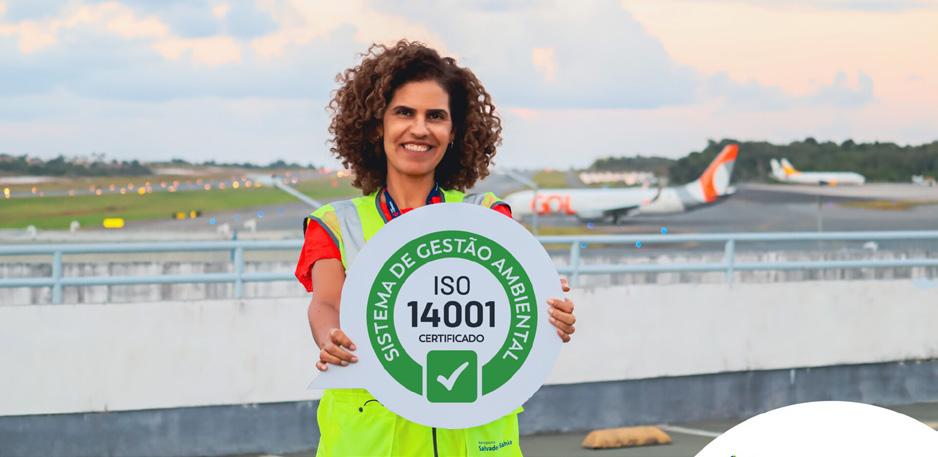
The centrepiece of operator Fraport's decarbonisation efforts will be the future electricity mix used at Frankfurt Airport, which will largely consist of renewable sources from 2026. By then, a Power Purchase Agreement (PPA) with German energy company EnBW should see around 85% of Fraport’s electricity needs being met by wind energy from the North Sea. Moreover, large photovoltaic systems (PV) at the airport will provide another significant proportion of required energy needs.
Solutions in the air include using sustainable aviation fuel, which could reduceCO2 emissions by up to 80% over the lifecycle of the fuel. Another solution is purchasing RECs, which can help meet carbon neutrality goals in the short term, until more permanent clean energy solutions replace them.
Technology and more granular, dynamic energy management can provide impactful solutions for decarbonisation. Many of these begin by using data about an airport’s energy consumption, including real-time, in-building data analytics, to help airport operators harness the surplus energy in their buildings.
Airports that can dynamically adjust energy use in response to grid conditions will be key to addressing energy affordability and equity and reducing emissions. By optimising energy usage and onsite power generation on the ground, and using sustainable aviation fuel in the air, airport administrators can achieve many of their short- and long-haul decarbonisation goals.


We focus on some of latest the IT news stories from ACI World Business Partners across the globe.
Budapest Ferenc Liszt International Airport (BUD) is set to enhance the passenger experience and optimise its operations by implementing Veovo's Passenger Predictability solution.
The passenger flow analytics platform will initially focus on preventing bottlenecks and efficiently allocating resources in the airport's security and check-in areas.
With an expected influx of travellers this summer, Budapest Airport will use data from multiple movement sensors and machine learning to understand passenger behaviour, predict the impact of events, and make informed, proactive decisions. The airport also plans to expand the technology from kerb to gate to benefit passengers throughout their airport journey.

Live and predicted queue wait-time information will also be displayed to provide accurate information to passengers about the expected queueing time, potentially reducing stress and anxiety and helping them take control of their journey.
Genetec's unified security platform, Security Center, has been chosen by Brazil’s Hercílio Luz International Airport in Florianópolis (FLN), to manage its physical security infrastructure, and provide operational insights.
Branded as Floripa Airport and managed by Zurich Airport Brazil, FLN was recently named the ‘Best airport in Brazil’ by the Brazilian National Civil Aviation Secretariat (SAC) and is one of the fasest growing gateways in the country.
“It was very important for us to choose a modern security system that could be totally integrated with the airport's critical operations,” says Kleyton Mendes, executive manager of Zurich Airport Brazil.
"Genetec Security Center has allowed us to implement state-of-the-art technology, and integrate new hardware, artificial intelligence and analytics tools, while increasing our cybersecurity posture."
Toronto Pearson International Airport, operated by the Greater Toronto Airports Authority (GTAA), has become the latest gateway to deploy artificial intelligence to improve gate operations.
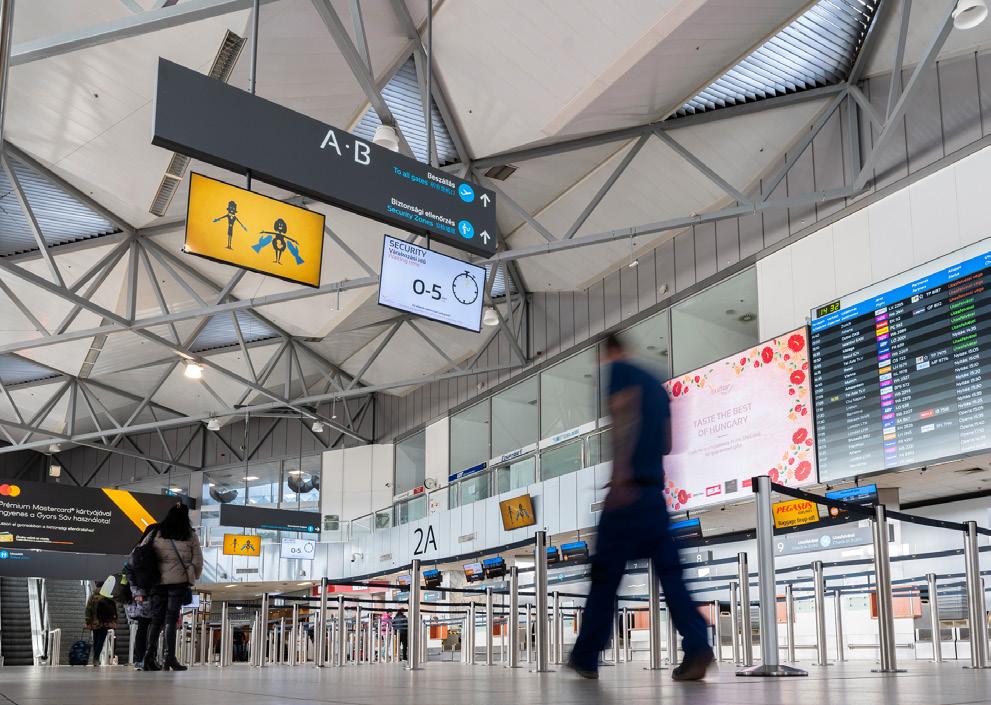
Assaia’s Turnaround Control technology is being rolled out at all 106 gates at the airport to increase operational efficiency, enhance safety and reduce environmental impact.

Assaia uses a combination of AI and computer vision to track exactly what is happening around the aircraft in real time. The resulting data is used to highlight inefficiencies, which can then be addressed, and provide highly accurate estimates of when the processes will be complete, to increase gate availability. Max Assaia CEO Max Diez, pictured above with GTAA CEO, Deborah Flint, said: “The airport is a highly regulated and highly monitored environment. However, until now, gate operations have not had this degree of systematic, thorough and measurable analysis.
"There are so many benefits, starting with the more efficient use of the gates and aircraft. We can also improve safety by tracking any unsafe practices. And the same applies to environmental performance, for example by identifying the extended use of auxiliary power units."
The Genetec platform currently manages over 500 cameras and 210 doors to administrative and critical areas of the terminal, such as boarding, arrivals and customs.
Because Genetec Security Center is based on an open platform, it can integrate a variety of operational systems and sophisticated analytics tools such as the ability to identify and track unaccompanied luggage and generate alerts so that appropriate security measures can be taken quickly and easily.
Dr Richard Plenty and Terri Morrissey reflect on the implications of ChatGPT for the world of work.
Can you tell if this article is written by a human or by a computer?
A year ago, this was a question that very few people thought worthy of consideration. But since ChatGPT was released in November 2022, the power and potential of the technology has stunned the world and posed fundamental questions about what it means to be human.
An AI chatbot that uses natural language processing to create humanlike conversational dialogue, ChatGPT can respond to questions and compose various written content, including writing articles, essays, social media posts and emails.
The speed of uptake has been phenomenal. ChatGPT has acquired over 100 million users in a few months. It is already being used to code, programme, read legal texts, and summarise research papers.
It has passed the US Bar exam in the 90th percentile and may be capable of correcting those very papers shortly. The entire plumbing of the professional world has the possibility of being reworked and new businesses set up based on AI tools.
In late March over 1,000 scientists, including Elon Musk and Steve Wozniak, called for a six month pause on the development of AI including ChatGPT-4 noting that “advanced AI could represent a profound change in the history of life on Earth and should be planned for and managed with commensurate care and resources”. Were they overreacting?
Perhaps not, at least as far as the world of work is concerned. Goldman Sachs predict the potential loss of over 300 million jobs globally as a result of “generative” AI such as ChatGPT. Those likely to be displaced include those in professional and managerial roles – including areas such as customer service – which have previously not been targets for automation.
On the other hand, there may be great opportunities. Sir Christopher Pissarides, professor of economics at the London School of Economics, and Nobel prize winner, seems optimistic. He
claims that AI could hasten advances in productivity, remove boring tasks and enable us to move to a four-day week. This would give all of us more leisure time for more creative activities.
We seem to remember hearing that argument some 30 years ago with the prediction of the “paperless office”, but now we are more overwhelmed than ever!
The CIPD (Chartered Institute for Personnel Development) issued some initial guidelines on the use and potential of ChatGPT in an article called “Impact of ChatGPT and other AI chatbots on the future of Work” on March, 27, 2023.
The article cautioned against using chatbots without building in checks for accuracies and biases. As the generative aspects of the technology are built primarily on inputs from the internet, its outputs can contain many inaccuracies, as well as reflecting prejudices, discrimination and bad practice from what has happened in the past.
For these reasons, the CIPD recommends that organisations need to create their own AI policy and limit its use to creating early drafts of documents. It claims that AI will have an impact on how we work, taking the “drudge” out of some tasks and making other roles redundant. Any time saved can be used to reinforce human skills and abilities such as critical thinking, empathy, creativity and problem solving.
Many organisations report that their people are currently so focused on transactional interactions they have little time to pause, take stock and use these skills. Rather than laying people off, employers should consider how the time saved can be used to create new opportunities and upskill employees.
Our view is that advanced AI does indeed represent a profound change in life on earth. The technology will not go away but will improve rapidly and it is up to us how we use and manage it. People will always be needed, but how and in what ways we contribute to achieving our goals will change radically.
And for those who are curious – yes, we did write this article ourselves without using ChatGPT! But next year, who knows?
Kansas City Aviation Department's aviation director, Patrick Klein, is to retire on May 31, 2023, after serving the City of Kansas for 25 years. One of his last acts was to oversee the successful opening of Kansas City International Airport's new terminal.
Vincent Harrison has left his position as managing director of Dublin Airport to take up the wider role of chief commercial and development officer for Irish airport operator, daa.
Munich Airport NJ LLC, the operator of the new Terminal A at Newark Liberty International Airport, has announced the appointment of Michael Kunz as the company’s new CEO.
Chris Dinsdale is the new president and CEO of Calgary Airport Authority. Born and raised in Canada, Dinsdale joins the airport authority from Budapest Airport where he held a similar position.
Malaysia Airports Holdings Berhad has appointed former Federal Court judge, YBhg Tan Sri Datuk Zainun Binti Ali, as its non-independent non-executive chairman.
Mike Dunn has announced his intention to step down as executive director of the Greater Rockford Airport Authority (GRAA) –operator of Chicago Rockford International Airport (RFD) – at the end of the year after more than 12 years in the position.
Terri Morrissey and Dr Richard Plenty run ACI’s Human Resources training. They received a Presidential Citation from the American Psychological Association in June 2022 for their leadership in advancing global psychology. Contact them at info@thisis.eu


We accelerate our clients’ performance by providing tailored, objective and empowering services capitalizing on international best practices.




